Refurbishment 2019 – 2021
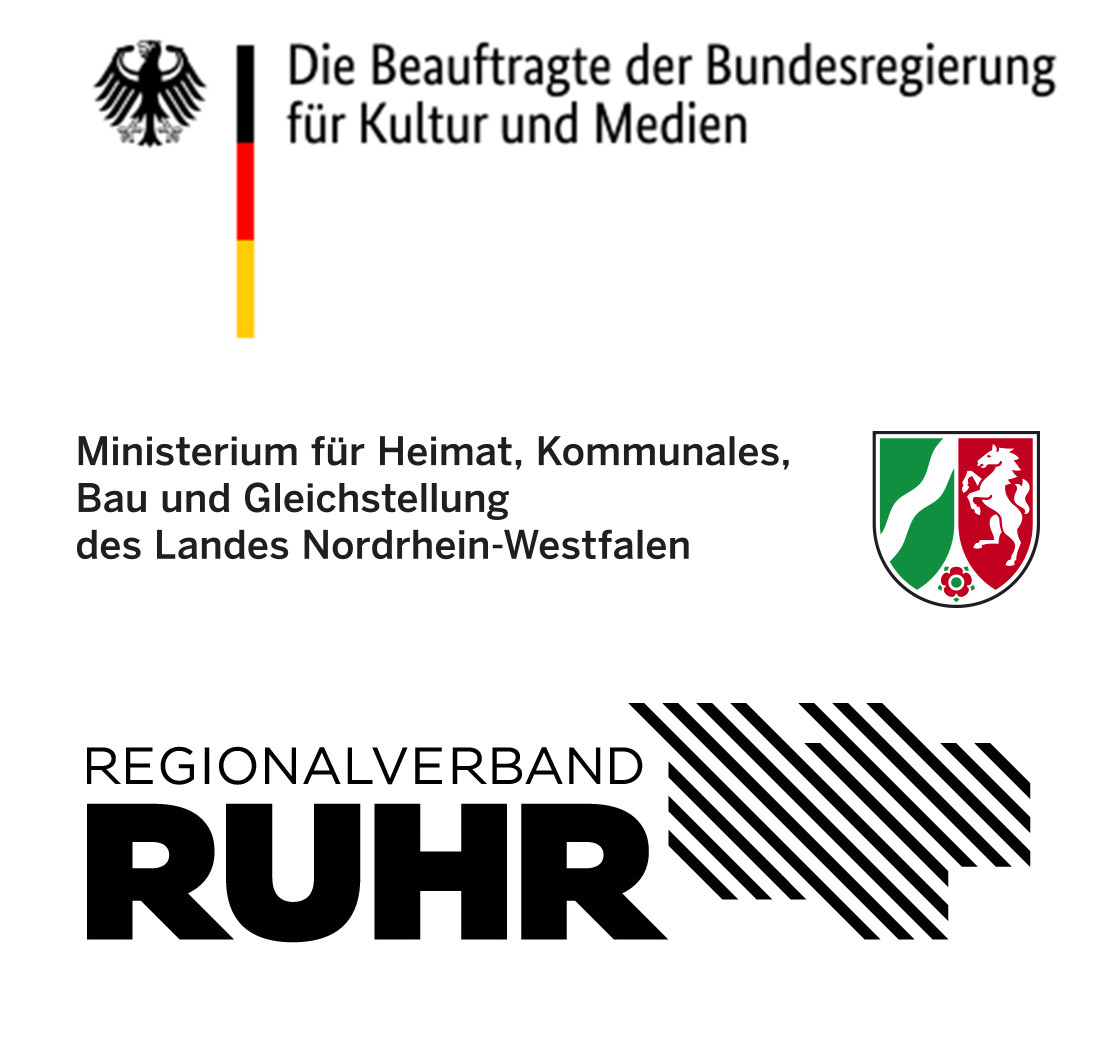
From the end of October 2019 until the winter of 2021, the Oberhausen Gasometer was extensively renovated. The funding commitments from the federal government, the state and the Ruhr Regional Association made the extensive refurbishment possible.
The first item on the long list of renovation measures was the foundation. This had become brittle in one place or another over the decades. A total of 180 metres of the foundation base was exposed and, where necessary, reinforced with steel mats and concrete. A total of 60 cubic metres of concrete were used in this construction phase. At the same time, industrial climbers and a 120-metre-high special crane were used to dismantle the circulation systems, staircases and blowers.
In total, an area of 70,000 square metres had to be treated in terms of corrosion protection. This included, in addition to the dismantled elements, the entire outer shell including the roof. These renovation measures required an enormous 30,000 square metres of scaffolding, which took almost five months to completely erect. The white tarpaulins around the scaffolding, visible from afar, fulfilled two important tasks. On the one hand, they guarantee dry and constant-temperature working conditions in the coming cold and wet season, and on the other hand, the paint and metal residues from the blasting of the outer shell remain on the construction site and can thus be disposed of properly. In the course of its recent history, the gasometer had received a total of fourteen layers of paint, all of which were removed during the refurbishment.
After that, the gasometer received a primer coat of zinc dust, followed by an intermediate coat and two top coats. The top coat is composed of a grey base colour with a reddish oxide tint. According to an analysis by the LVR Office for the Preservation of Monuments in the Rhineland, this colour was already used in the past as the first top coat of the gasometer after its reconstruction in 1949.
The corrosion protection work on the roof posed a particular challenge because the load-bearing capacity of the roof structure was limited. Therefore, remote-controlled robots were used to loosen the old layers of paint by means of water jets. Afterwards, the roof was primed and finalised with a grey top coat. The underside of the roof, the interior ceiling, also had to be derusted and coated by hand. However, this was only possible with a special suspended scaffolding construction, which was mounted directly under the roof of the gasometer, at a height of almost 110 metres. This was followed by the major cleaning inside and the dismantling of the scaffolding construction on the façade, which turned out to be more time-consuming than planned.
Then, at the beginning of October 2021, the current exhibition "The Fragile Paradise" could start.
The Gasometer construction site diary shows the small and large renovation steps on the way to the reopening.
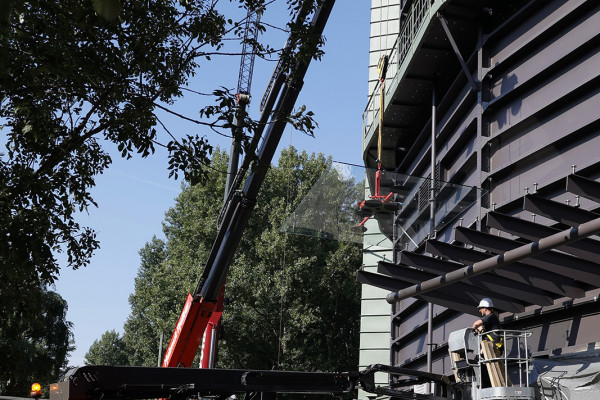
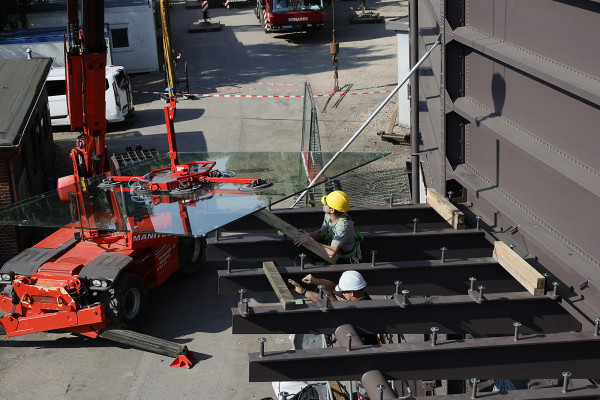
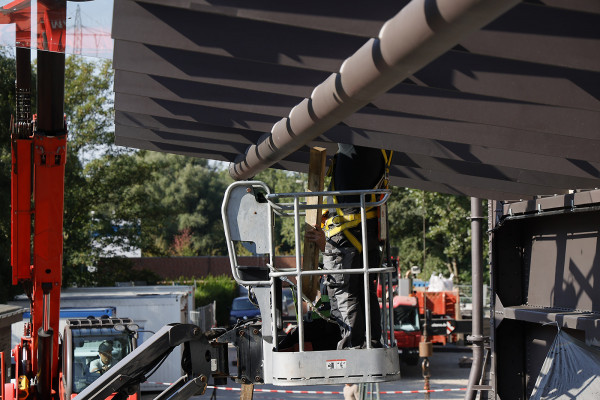
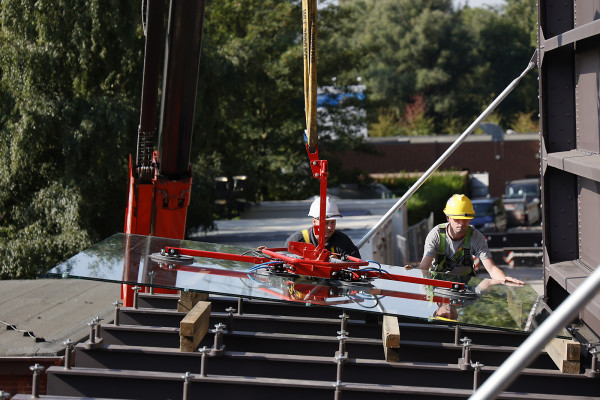
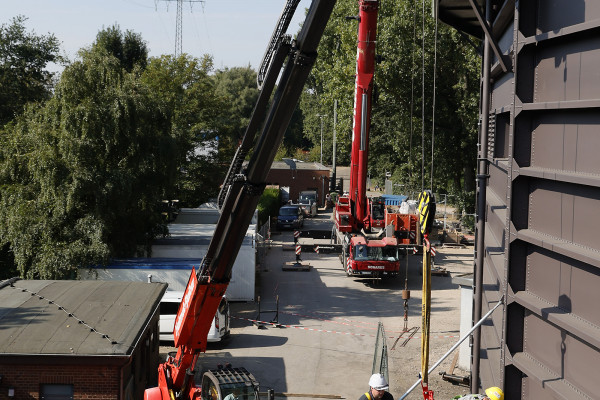
Entrance area
The Gasometer is dressing up for the grand opening on 1 October. Last week, the entrance area was given a chic new glass roof. The entrance portal underneath will also be renovated in the coming days.
Construction site diary in September 2021.
Fotos: Dirk Böttger
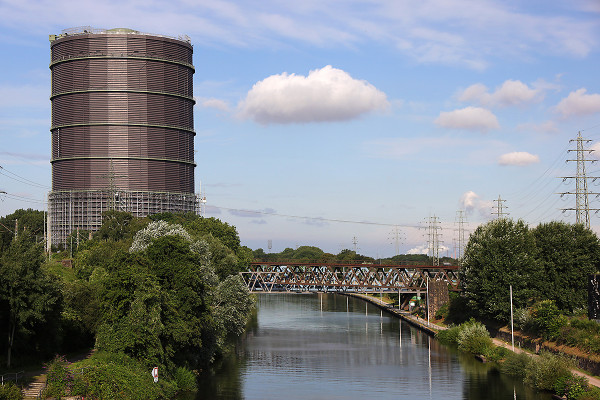
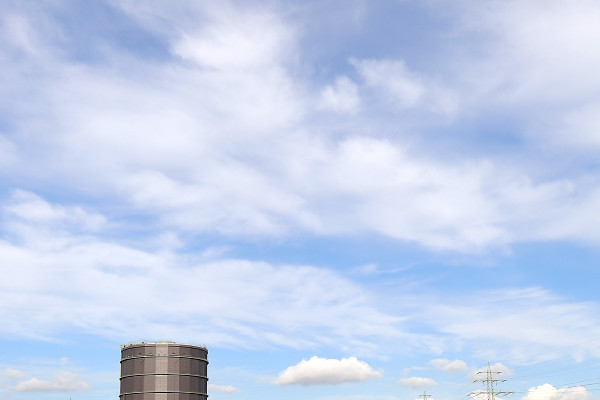
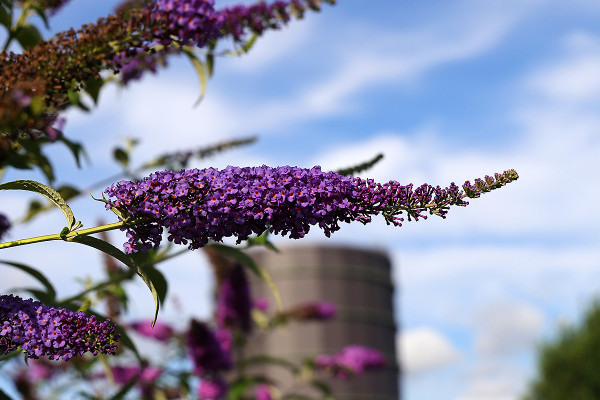
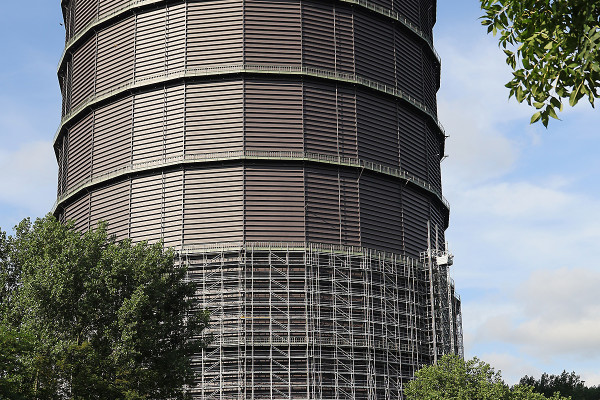
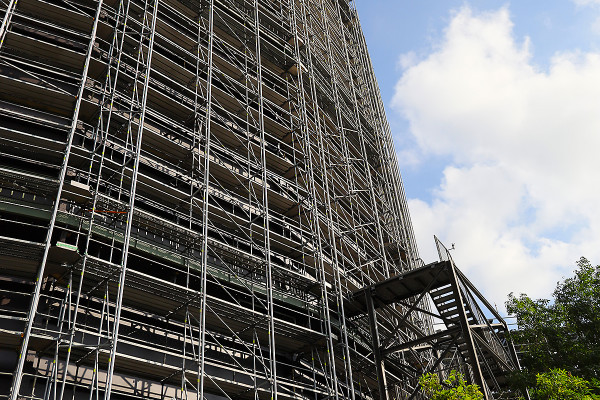
Near and far
The scaffolding construction is making good progress. From a distance, it almost looks as if the gigantic facade scaffolding on the Gasometer has already been completely dismantled. On closer inspection, however, it can be seen that the lower two circuits are still scaffolded. But even in these areas the scaffolding will be gone by the end of August. Construction site diary in August 2021.
Translated with www.DeepL.com/Translator (free version)
Fotos: Dirk Böttger
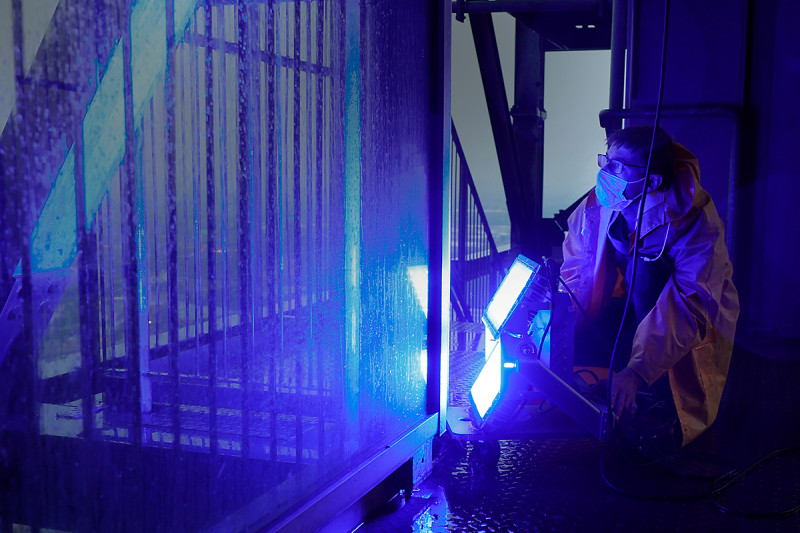
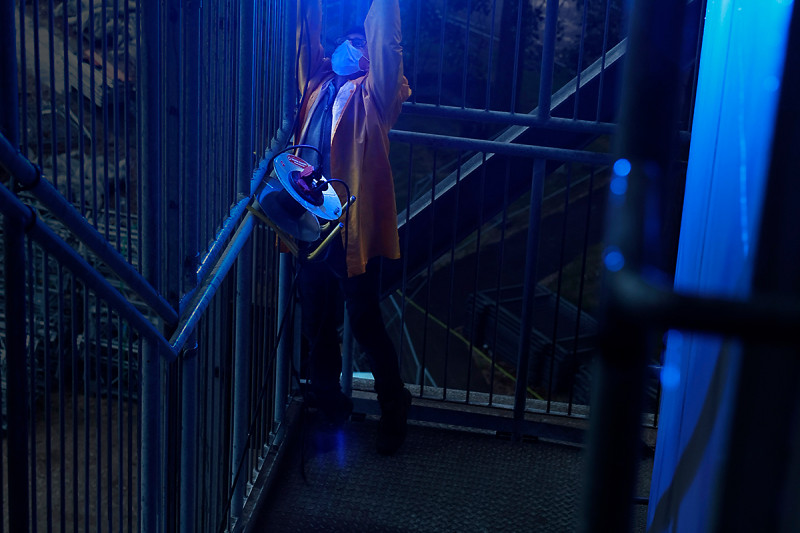
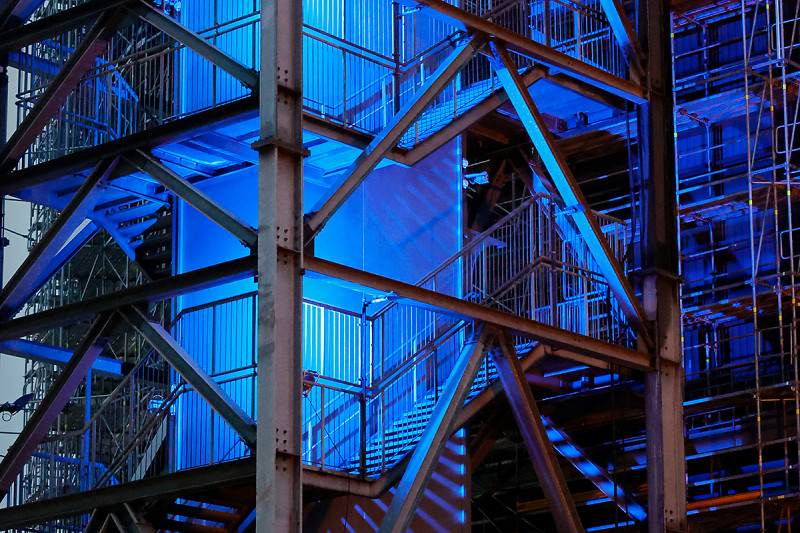
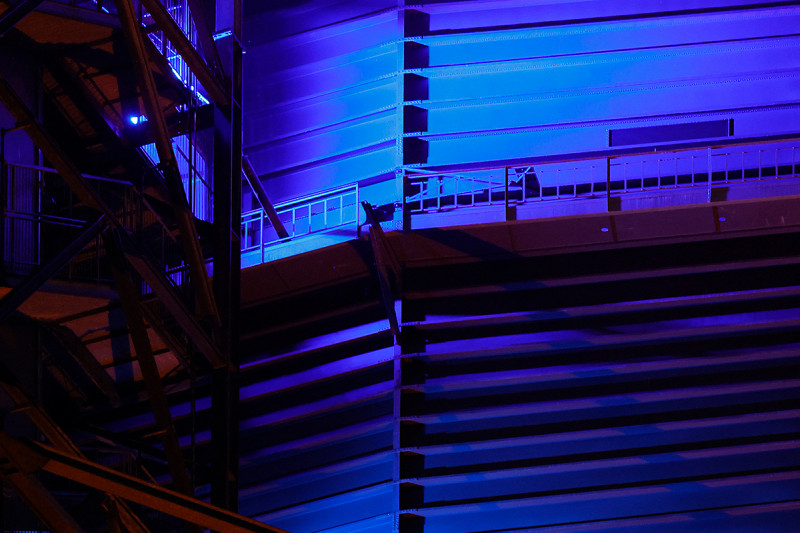
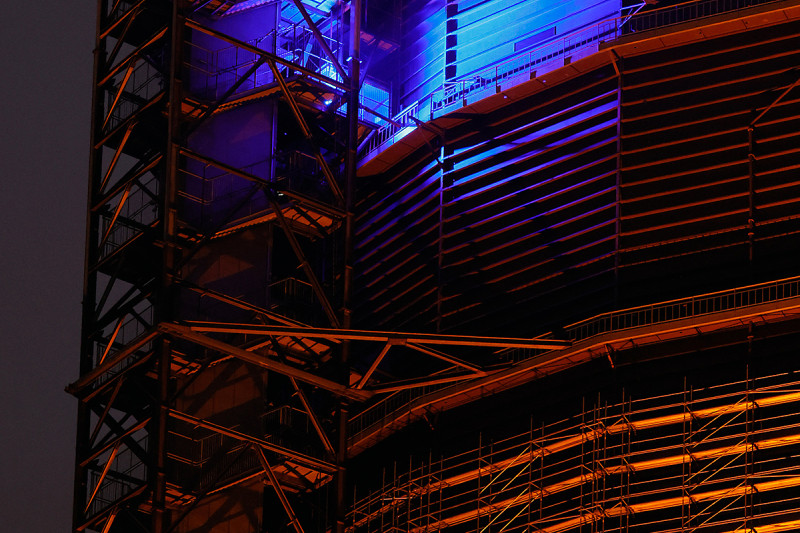
Blue hour
Anyone who looked towards the Oberhausen landmark after sunset on Tuesday evening could see blue skies despite dark clouds and rain showers. The reason: parts of the Gasometer were illuminated in the most varied shades of blue. The aim of this light test was to find the right lighting for the blue ring of light and the stair tower of the Gasometer. In the course of the refurbishment, the Gasometer will be fitted with energy-saving LED lighting, the colour of which will be based on the previous Royal Blue. Construction site diary in August 2021.
Fotos: Dirk Böttger
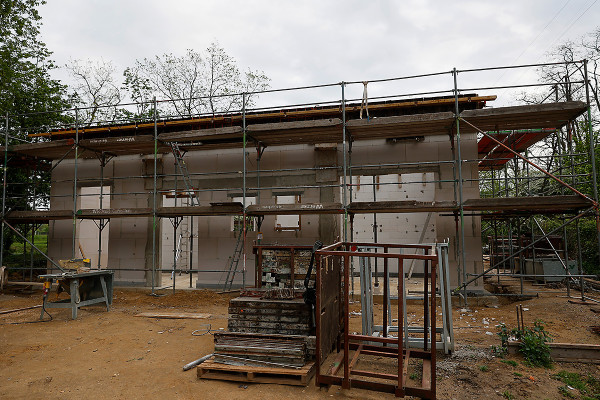
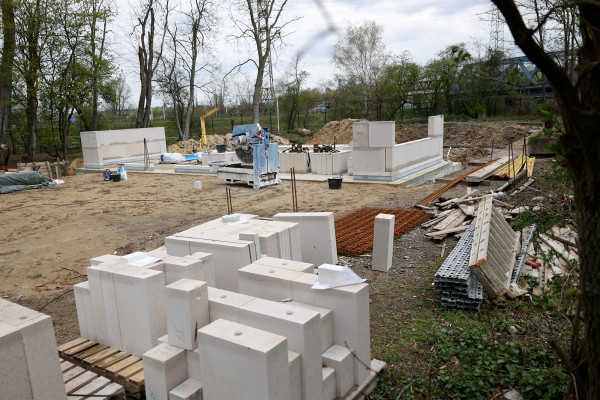
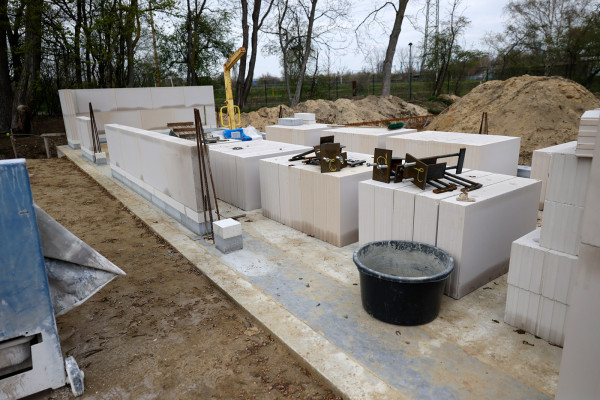
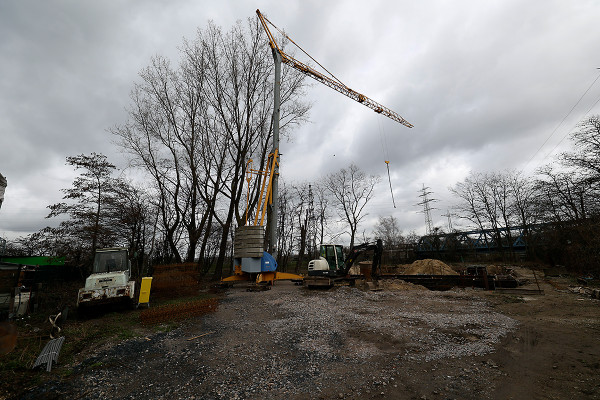
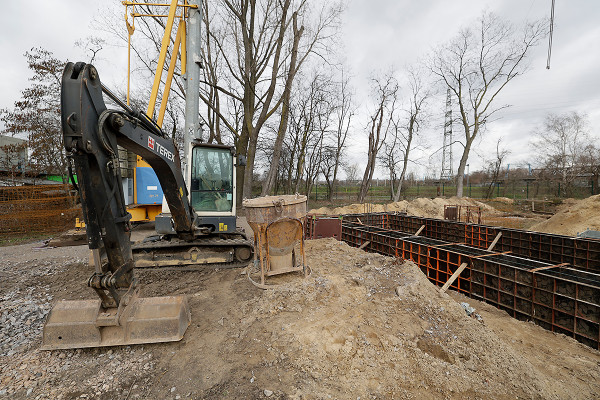
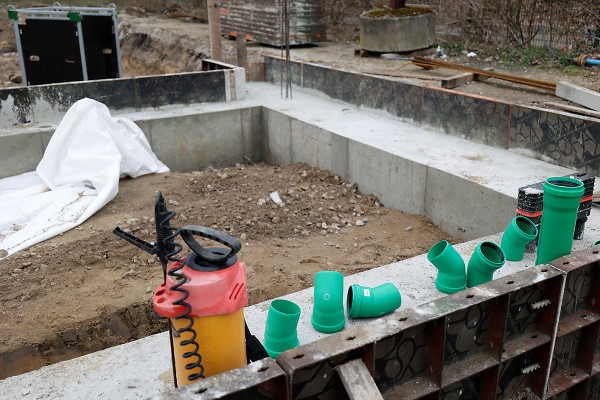
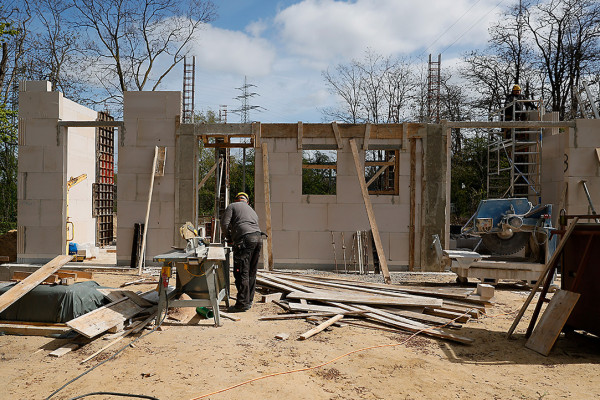
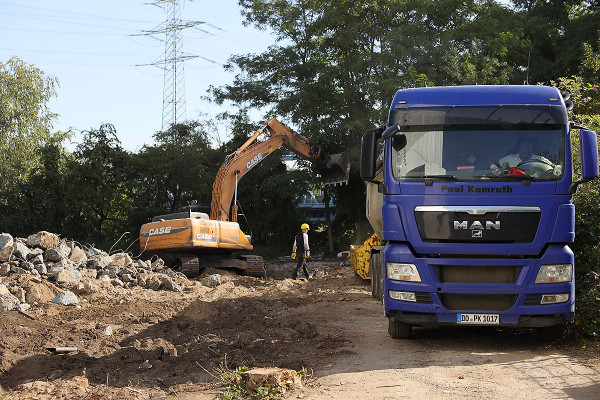
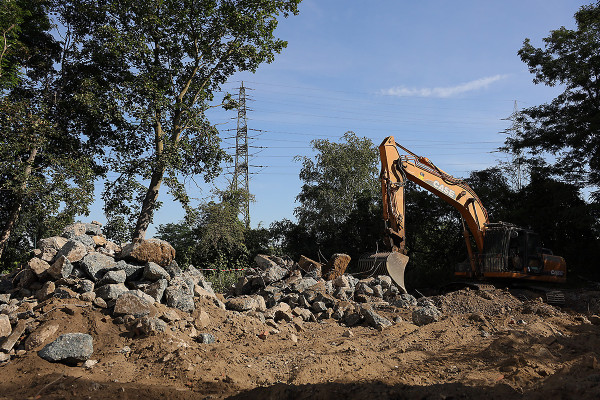
There was once upon a time....
... a small warehouse that stood between the gasometer and the Rhine-Herne Canal, largely unnoticed by visitors. The emphasis here is on "stood", because the building was in serious need of renovation and was already demolished last year. A new building is now being constructed on the same site. Construction site diary in May 2021
Fotos: Dirk Böttger
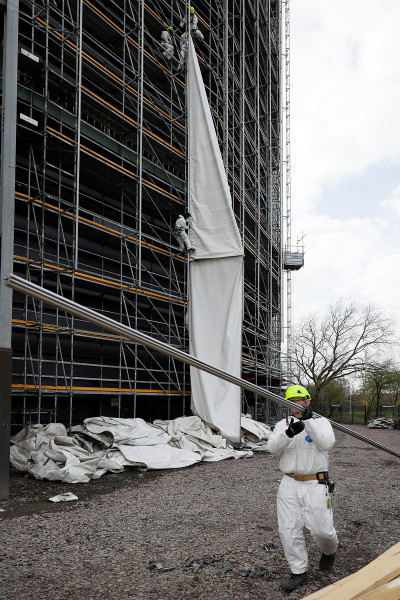
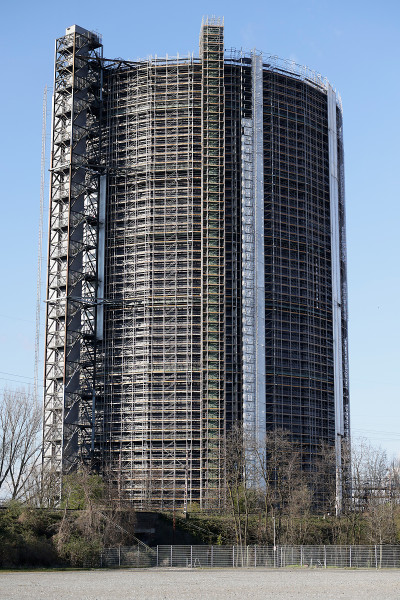
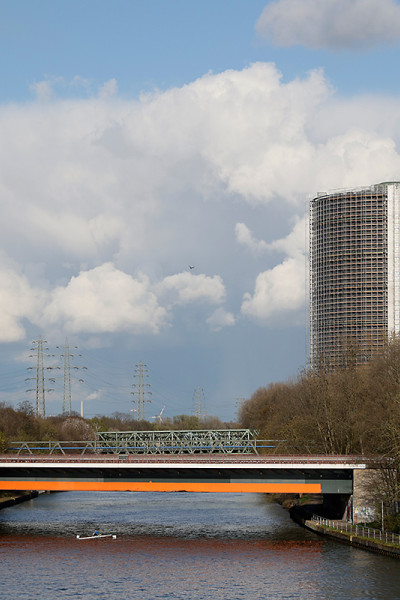
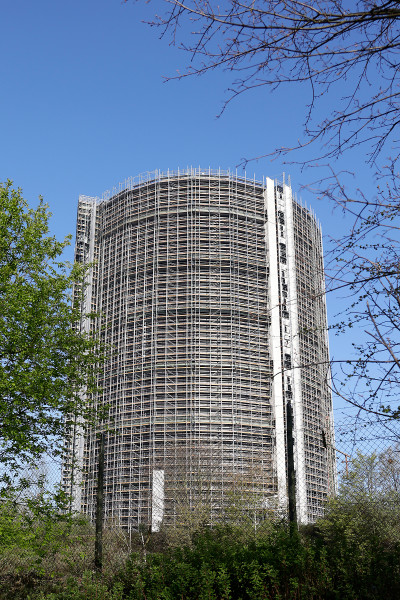
Unveiled!
The covers have come off! After days of effort, the Gasometer now shines again in its new "old" colour for all Oberhausen residents. The white tarpaulins that covered the entire scaffolding have been largely taken down. Now it's time to dismantle the 1000-ton scaffolding.
Construction site diary in April 2021.
Fotos: Dirk Böttger
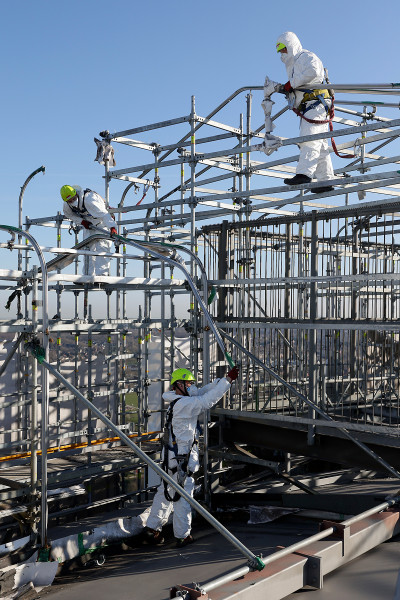
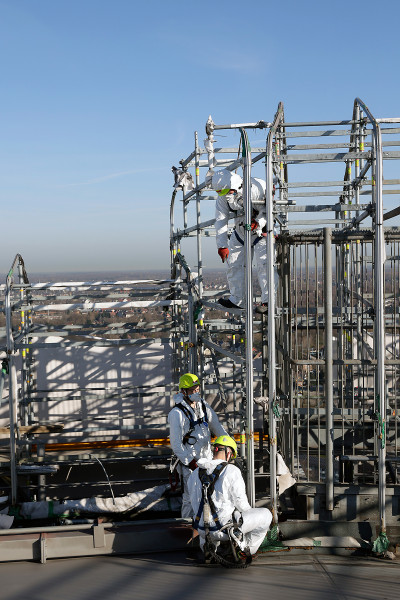
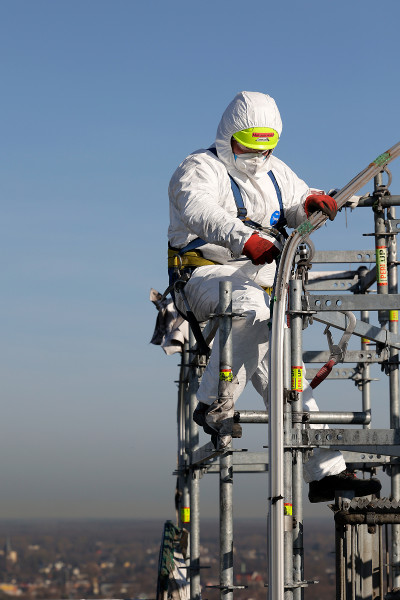
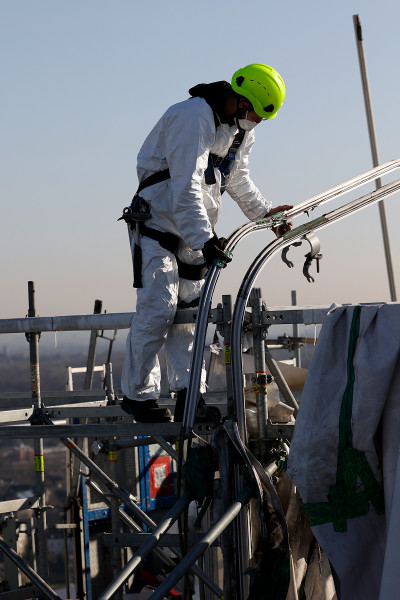
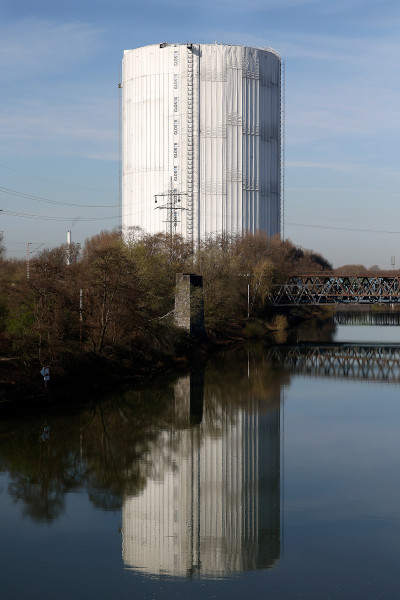
Unveiling
An important milestone in the renovation of the Gasometer has been reached. The corrosion protection work on the outer shell of the industrial monument has been completed. This means that the dismantling of the 30,000 square metre enclosure can now begin. The people of Oberhausen can now catch a glimpse of the new old colour of their landmark for the first time.
Although the 1,000-tonne façade scaffolding will initially block the unobstructed view of the cathedral of industrial culture, this will also be dismantled in the next six weeks. After that, the gasometer will be given back its original appearance: the circumferences, staircases and the characteristic blowers will be installed with the help of a special crane and industrial climbers. This, too, will take time, four weeks are estimated. Finally, the outside facilities will be restored. Construction site diary in April 2021.
Fotos: Dirk Böttger
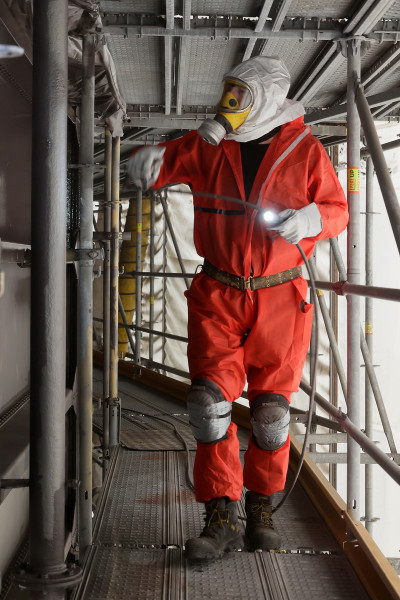
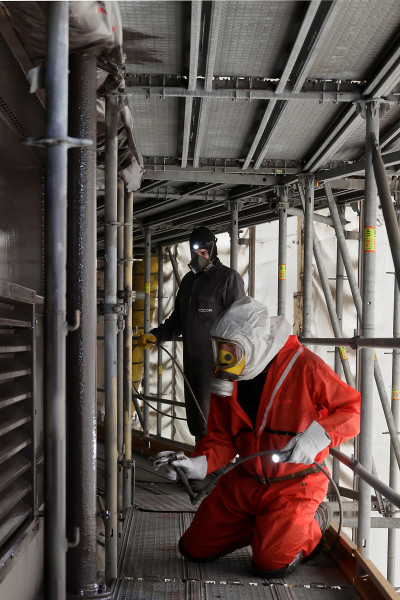
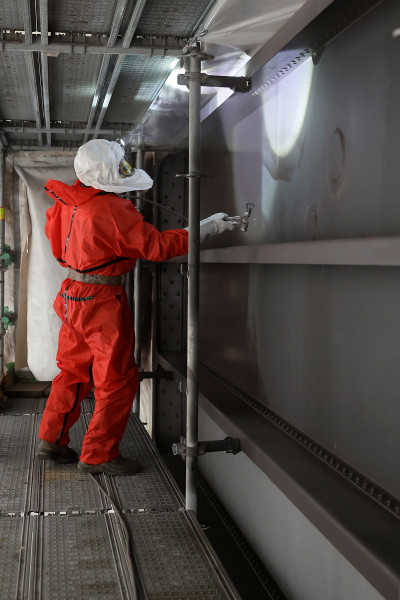
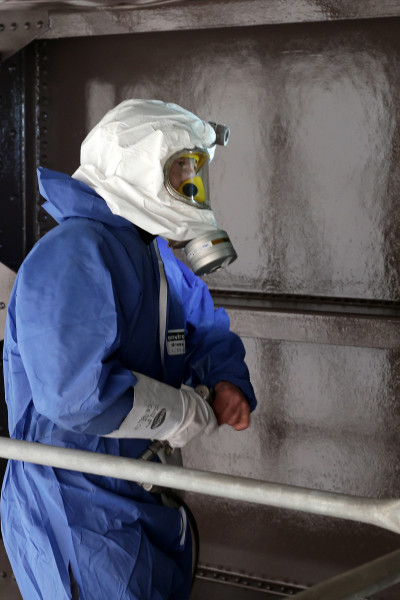
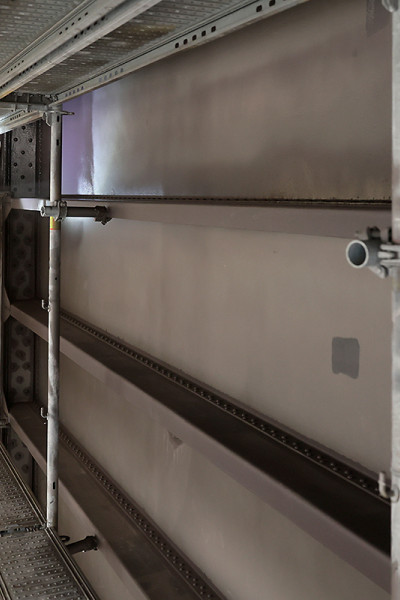
Painting
Before the covers come off on the gasometer, the corrosion protectors are putting the finishing touches to it. The final metres are coated with the new topcoat. The new colour mixture - a grey base colour with a reddish oxide tint - is based on the original colour used when the Gasometer was rebuilt in 1949. However, micaceous iron ore was added to the new top coat, which increases the corrosion protection and also makes the gasometer literally shine when the sun is low in the sky.
Construction site diary in March 2021.
Fotos: Dirk Böttger
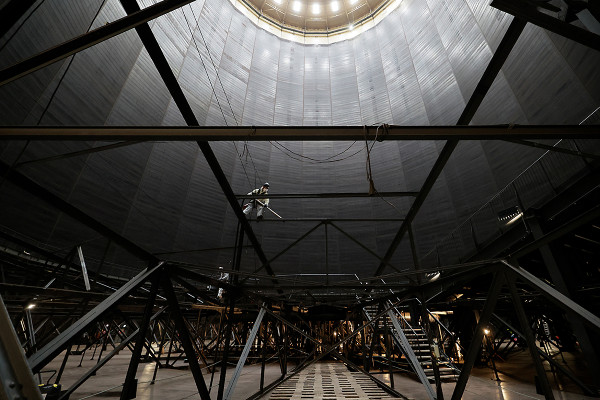
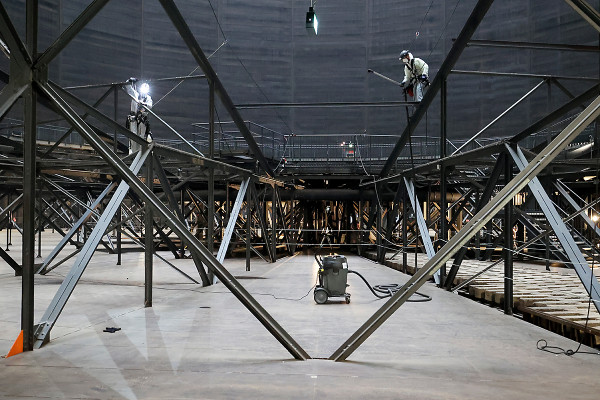
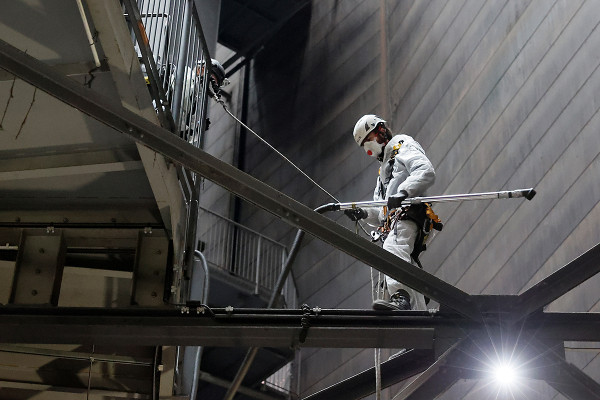
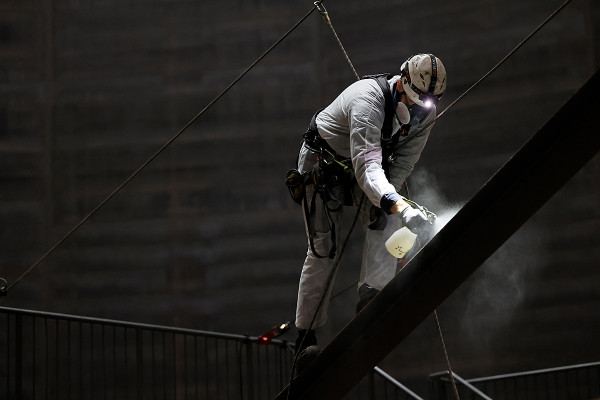
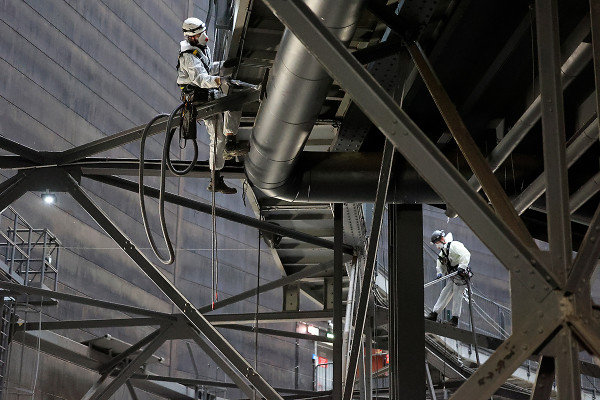

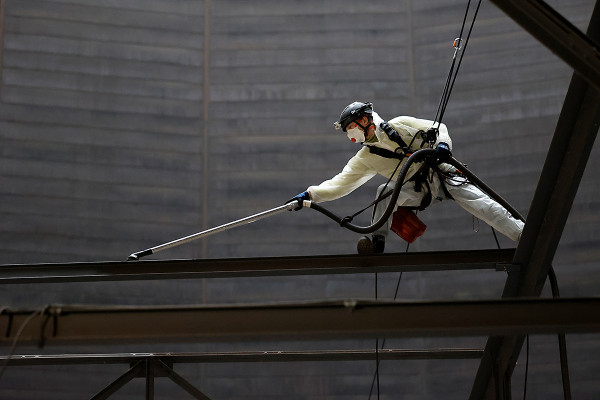
The big clean-up
Spring cleaning in the Gasometer is particularly thorough this year. Well secured, the cleaners are freeing every steel strut inside from dust and dirt. And there is a lot of that around the ring. The cleaning of all surfaces in the Gasometer will take a good two weeks, after which the construction of the new exhibition "The Fragile Paradise" will begin. Construction site diary in March 2021
Fotos: Dirk Böttger
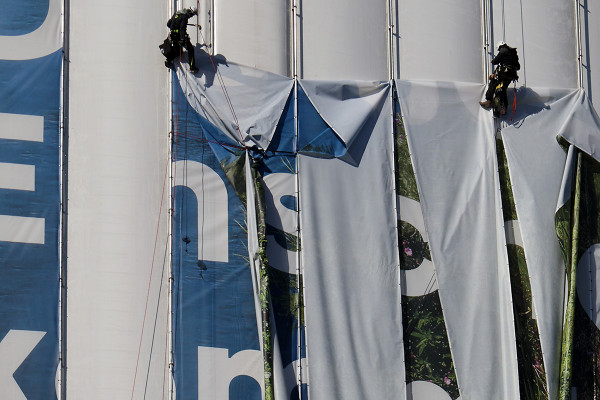
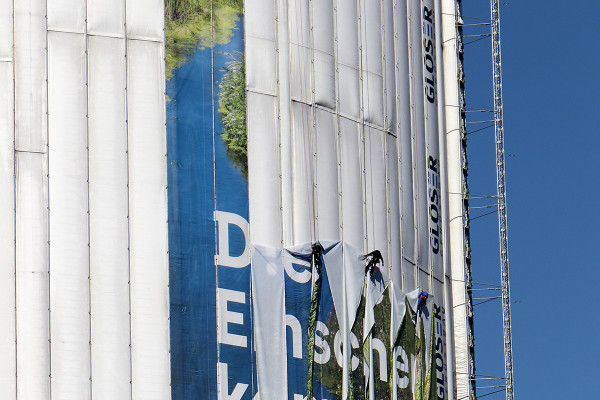
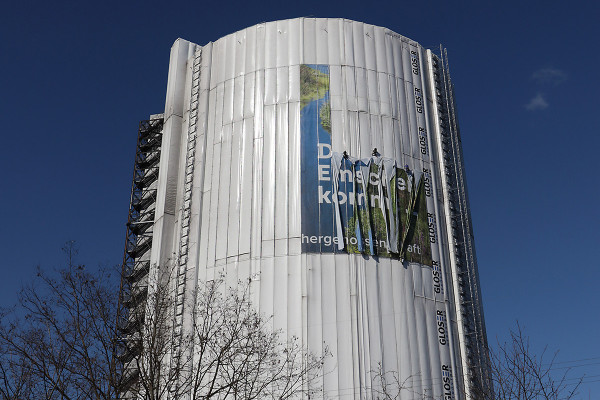
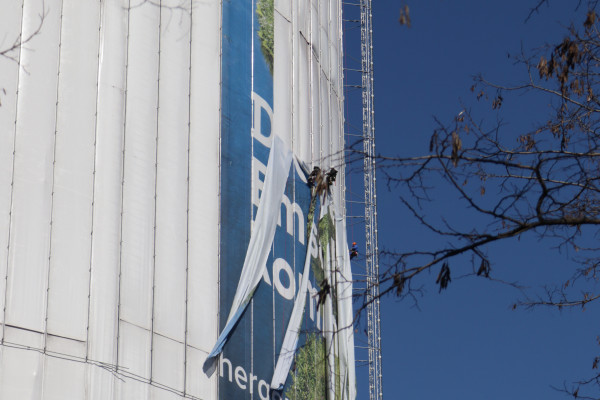
Dismantling
Industrial climbers from Höhenhandwerk dismantle the EMSCHERGENOSSENSCHAFT mega poster. Another step towards "disarmament". Towards the end of the month, the facade scaffolding is dismantled.
Construction site diary in March 2021
Fotos: Elena Marie Drescher
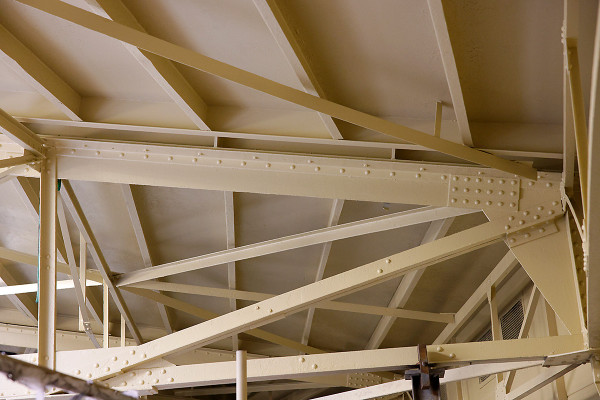
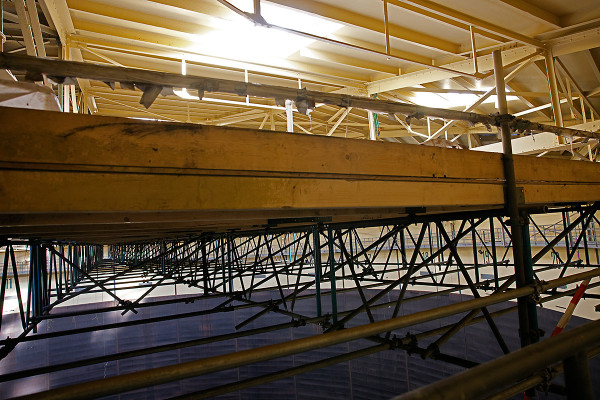
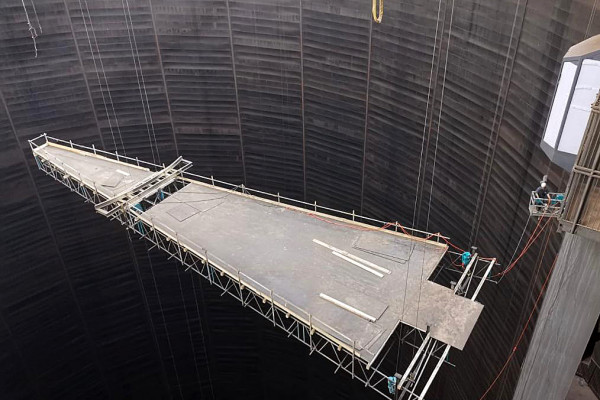
########In the hover
A whiff of Star Wars wafted through the Gasometer as the ceiling scaffolding floated through the 100-metre-high airspace. All that was missing was Luke Skywalker and Darth Vader having a laser sword fight. The fact is: the renovation of the interior ceiling has been completed and the interior scaffolding is no longer needed. The other photos show the freshly painted interior ceiling.
Construction site diary in March 2021
Fotos: Auerbach/Böttger
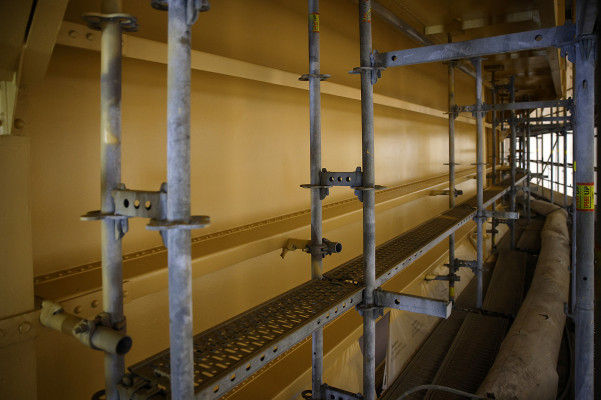
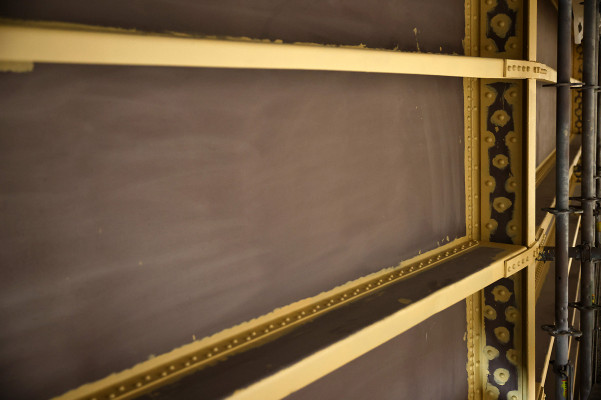
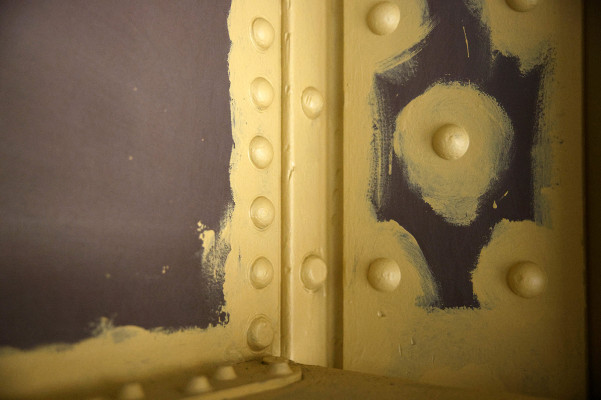
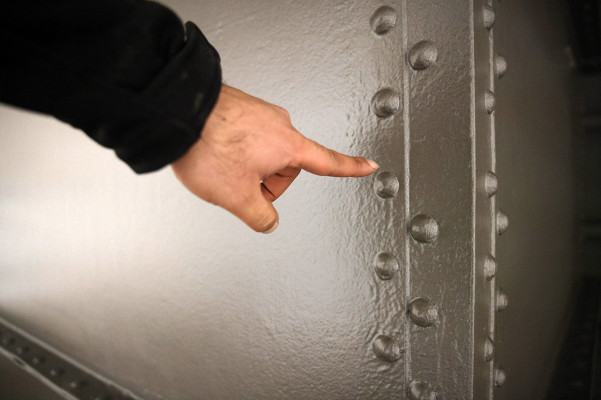
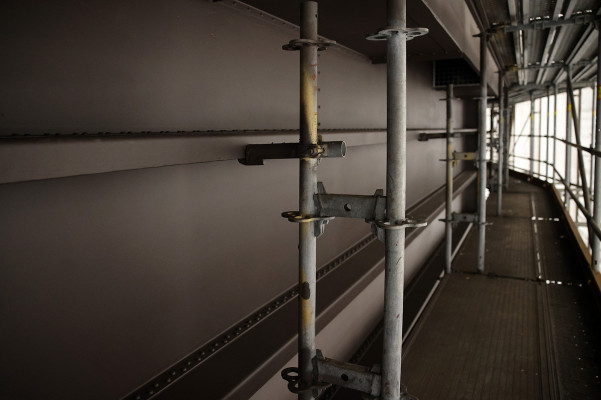
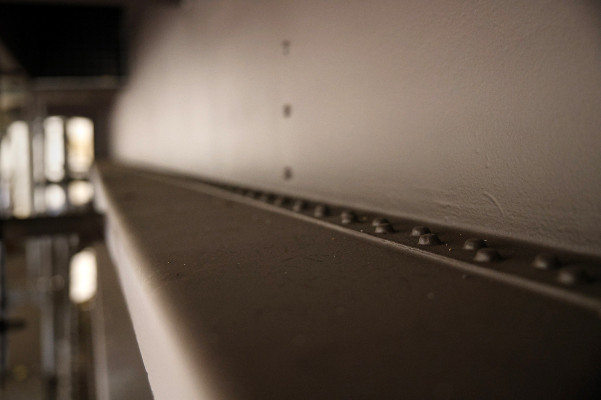
Layer work - the new colours of the Gasometer
The Gasometer is receiving four new coats of paint as part of the refurbishment. The grey primer coat of zinc dust is followed by a first, yellow intermediate coat. The colour of the second intermediate layer is similar to that of the final top layer with its grey base. This is composed of a grey base and an oxide-reddish admixture. A comparable colour mixture was already used for the first coating after the reconstruction of the gasometer in 1949. In contrast to the original colour, micaceous iron ore has been added to the current top coat. This not only helps to protect against corrosion, but also makes the Gasometer sparkle in the low sun. Construction site diary in February 2021
Fotos: Dirk Böttger
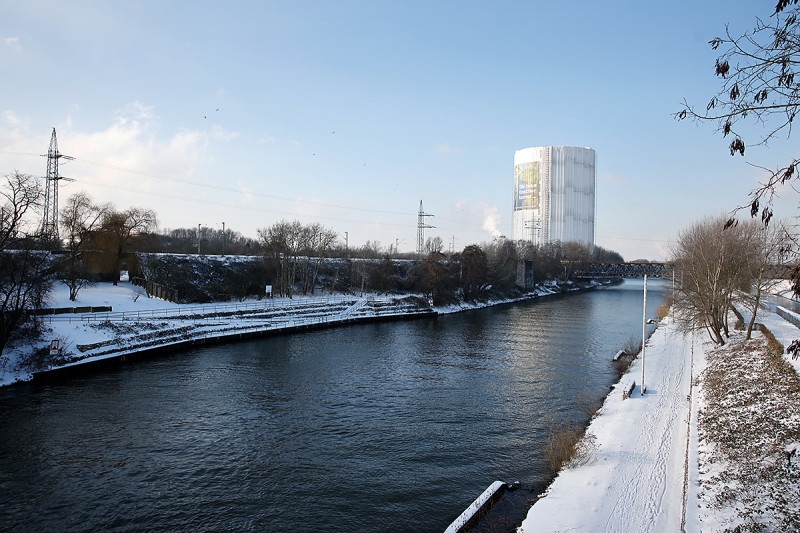
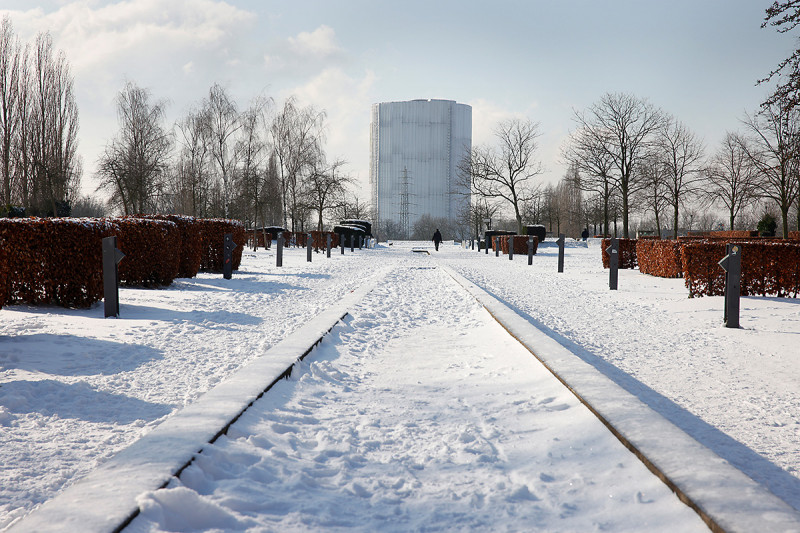
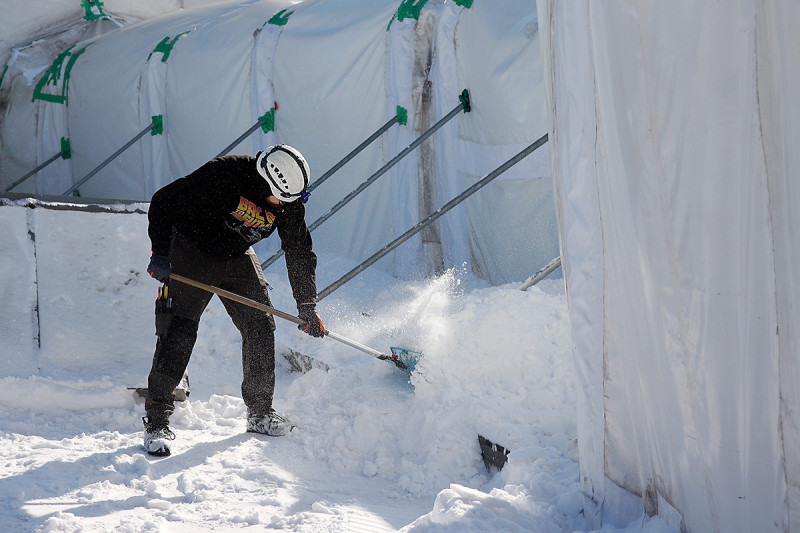
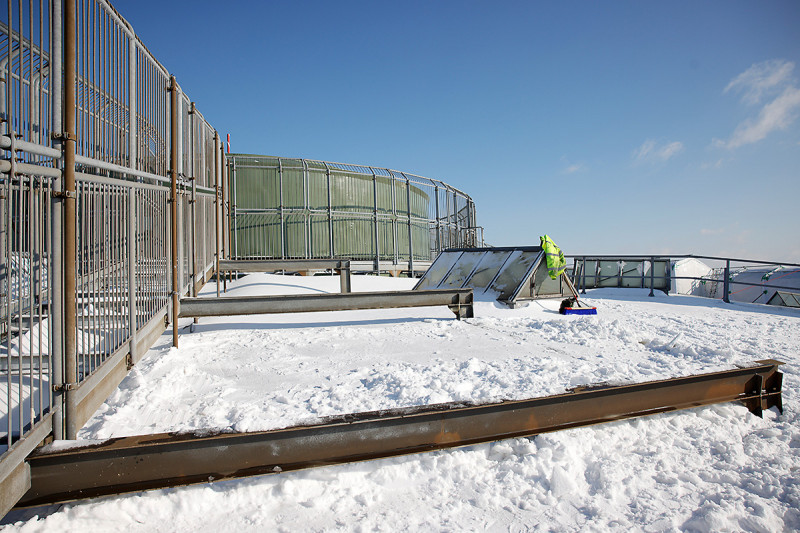
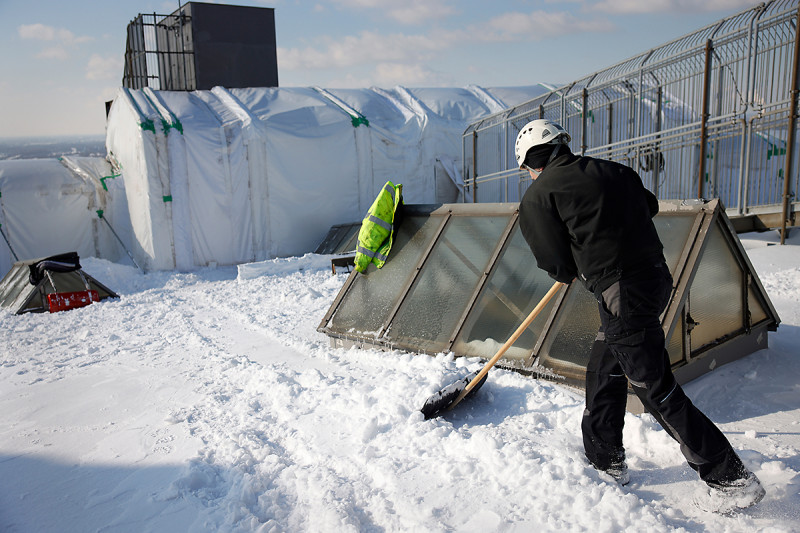
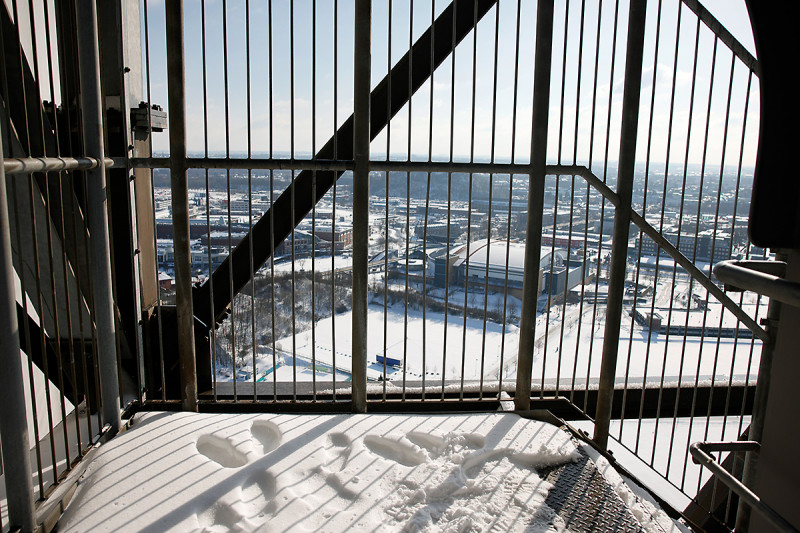
Ice time
In windy and icy temperatures, the industrial climbers from Höhenhandwerk are busy shovelling snow on the roof of the Gasometer. Gusts of wind had piled the snow up to half a metre high in some places. To ensure that the snow load, in combination with the suspended scaffolding currently mounted on the interior ceiling, does not affect the stability of the roof, they have to be busy shovelling. Seen from a distance, the colour of the enclosed gasometer blends perfectly into the snowy landscape. Construction site diary in February 2021
Fotos: Dirk Böttger
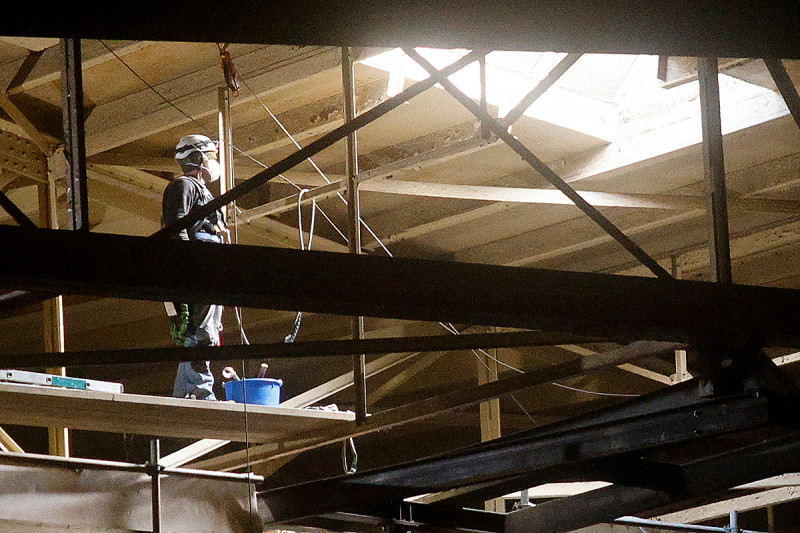
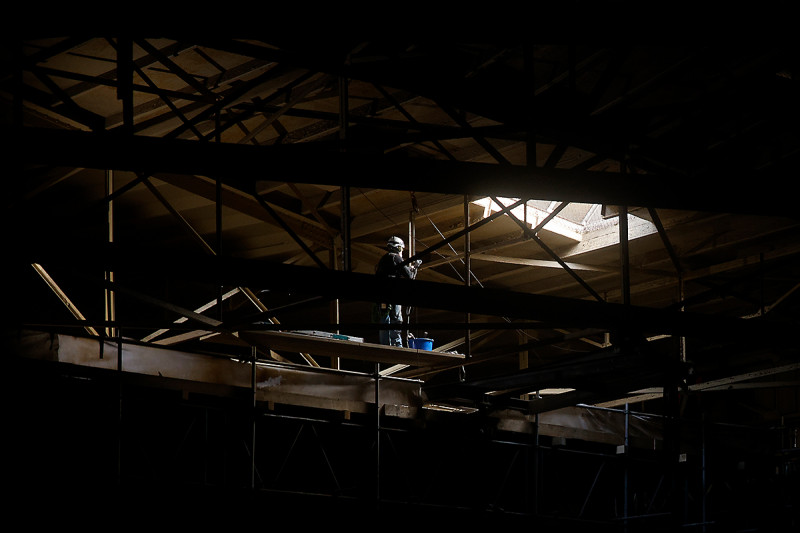
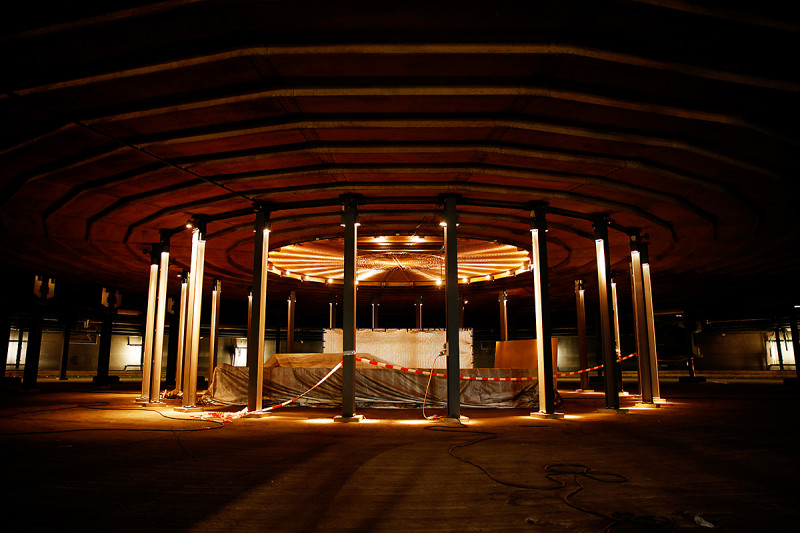
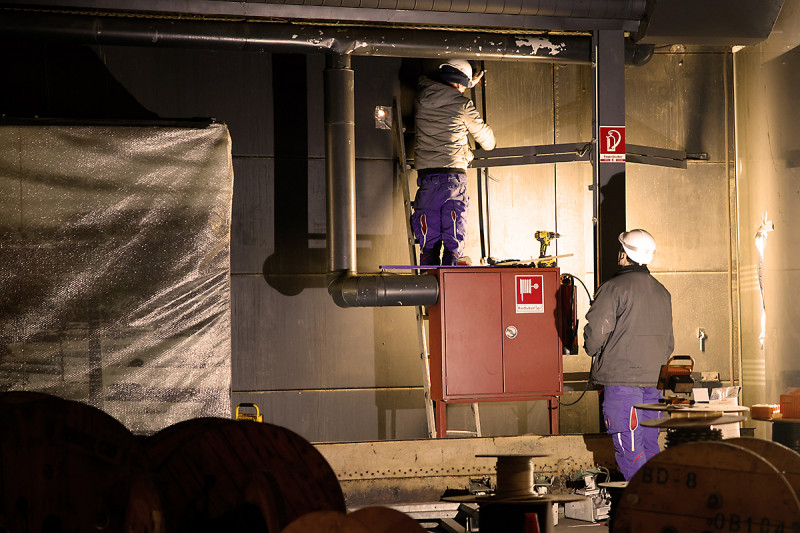
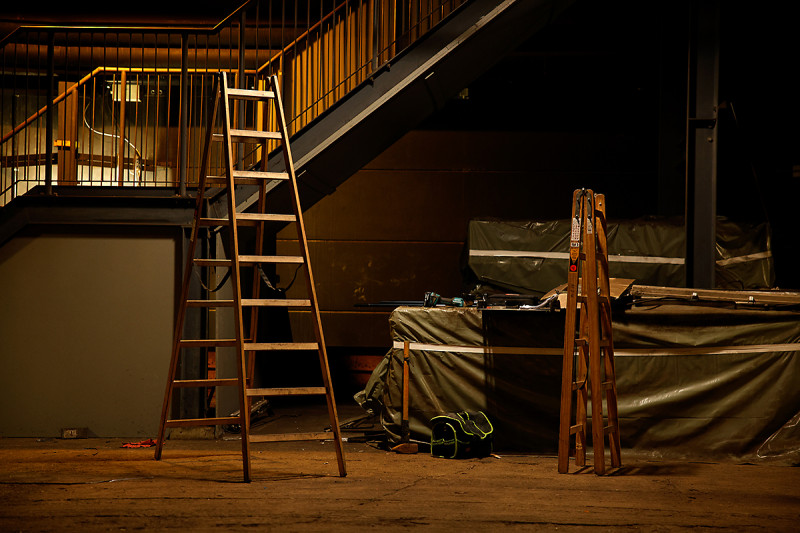
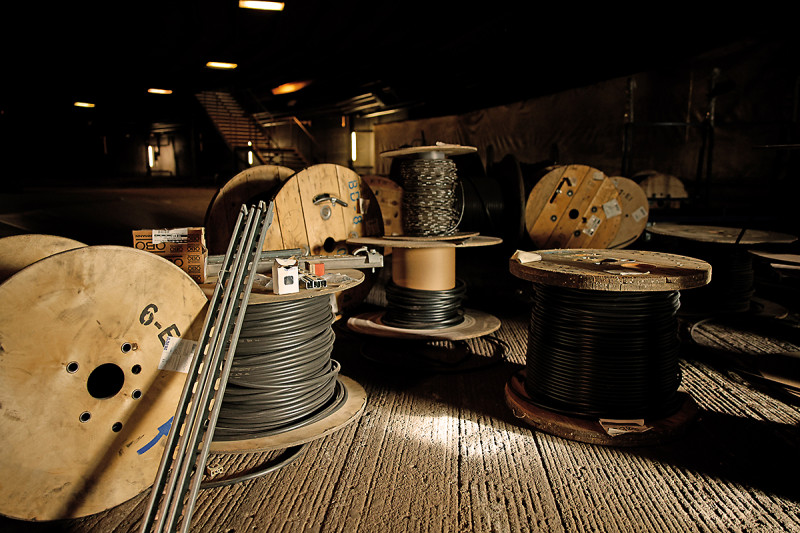
The end of darkness
The interior of the gasometer had been in a state of complete darkness. The dormer windows were covered, and apart from sparse emergency lighting, there was hardly any light inside.
Only the workers who are currently carrying out the corrosion protection work on the interior ceiling are equipped with a few construction lights. In the last few days, the protective covers on the dormers have been removed piece by piece, and a little daylight is once again falling into the gasometer. In addition, specialist firms are currently checking the electrical installations and, where necessary, laying new cables. Let there be light ...
Construction site diary in January 2021.
Fotos: Dirk Böttger
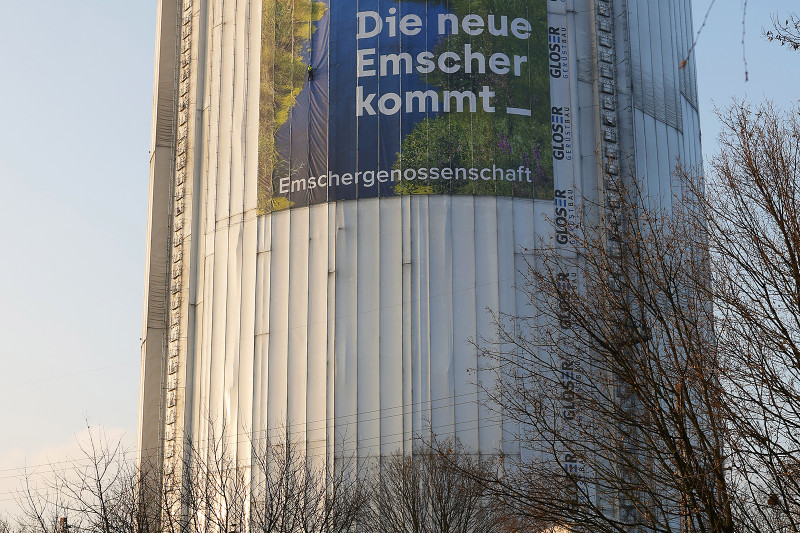
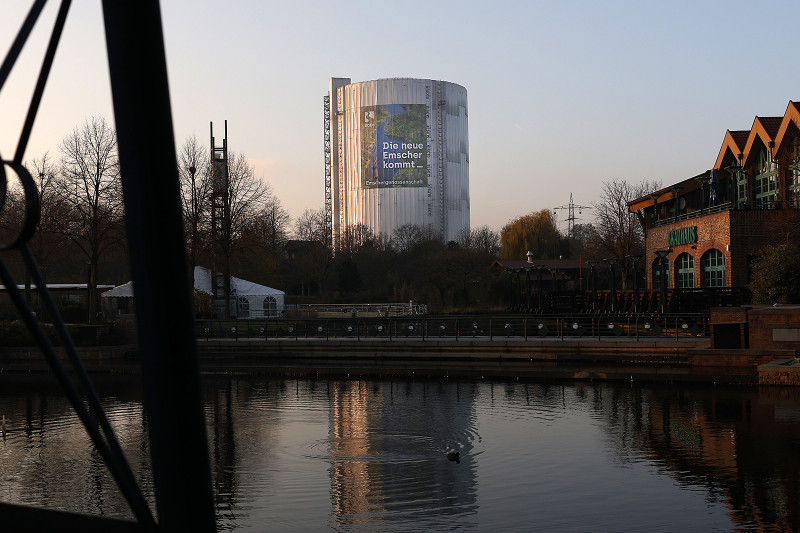
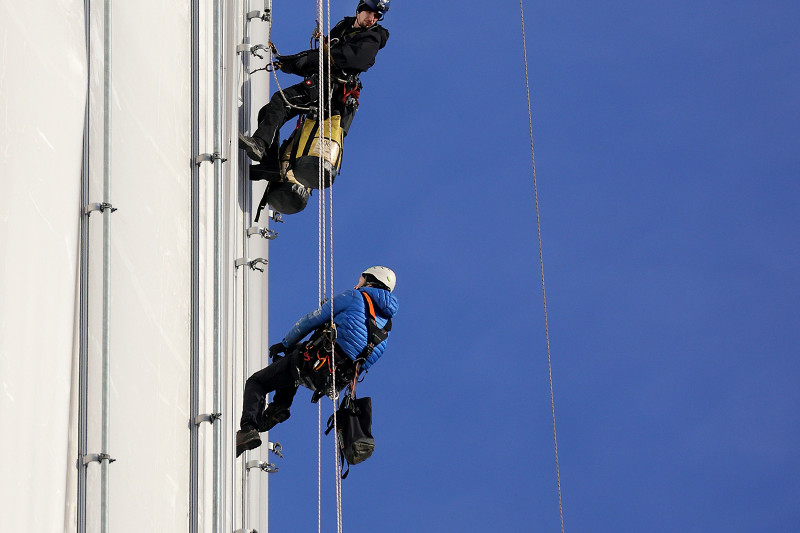
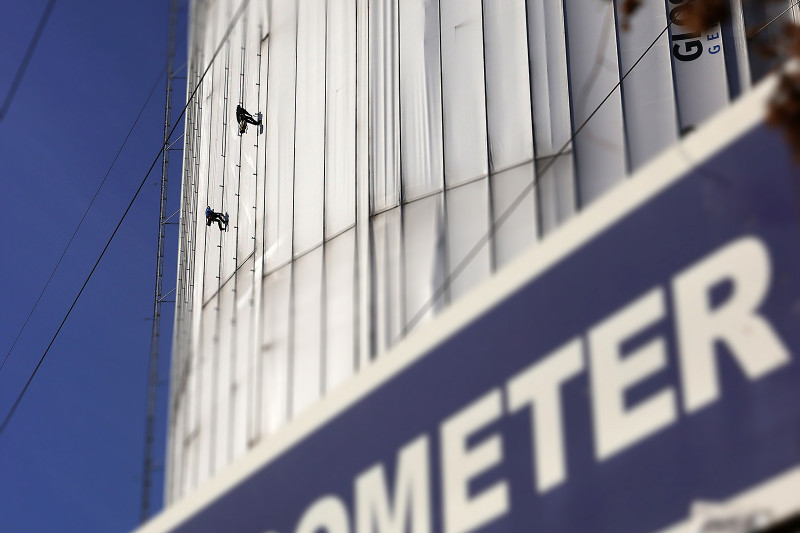
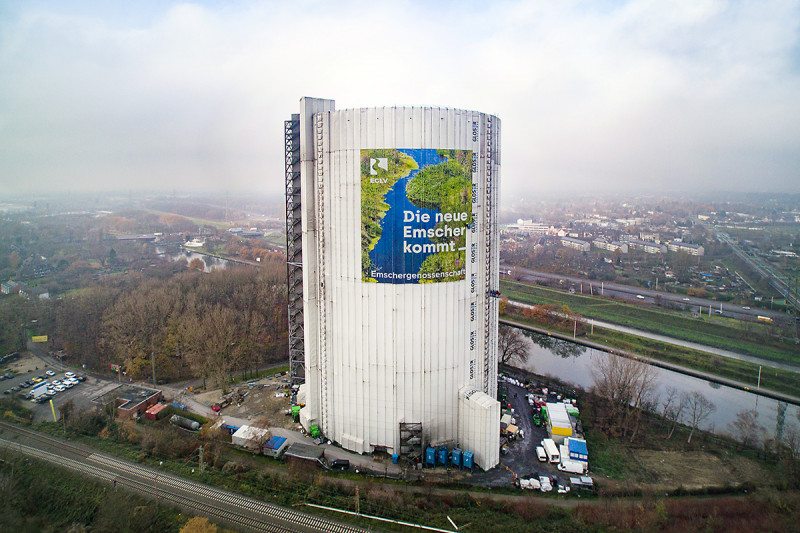
Megaposter and megaproject
At the Gasometer, a mega-poster of the EMSCHERGENOSSENSCHAFT for the mega-project Emscherumbau is currently being hung up. It was attached to a special substructure by industrial climbers and is clearly visible from the Centro side. Construction site diary December 2020
Fotos. Dirk Böttger
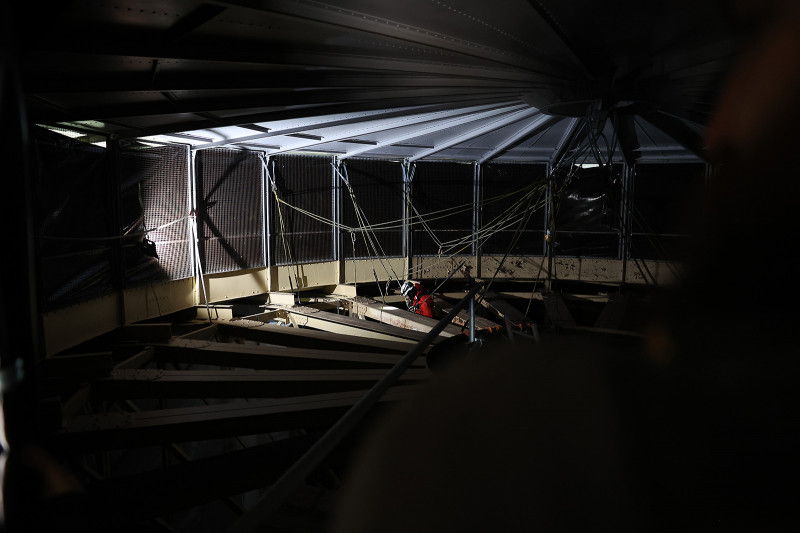
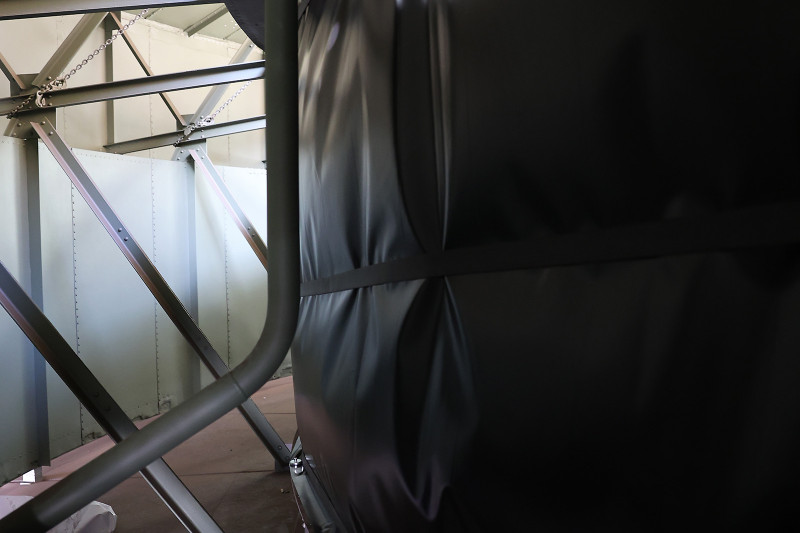
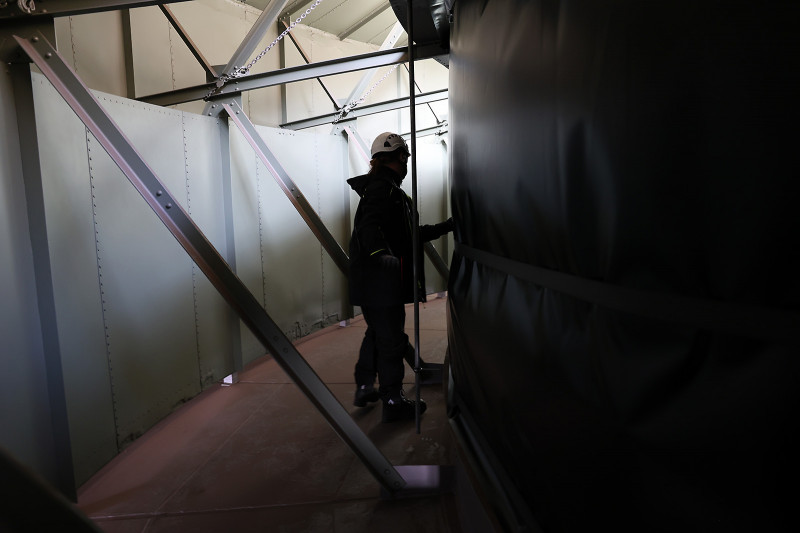
Darkening
The dismantling of the scaffolding on the Rotunda is almost complete. As a first preparation for the exhibition, the rotunda will be darkened with a black foil. This is to prevent stray light from falling into the interior of the Gasometer and impairing the projection of the gigantic globe. The earth sculpture in the 100-metre-high airspace of the Gasometer is the highlight of the upcoming exhibition "The Fragile Paradise", which will be shown in the Gasometer from spring 2021. Construction site diary November 2020
Fotos: Dirk Böttger
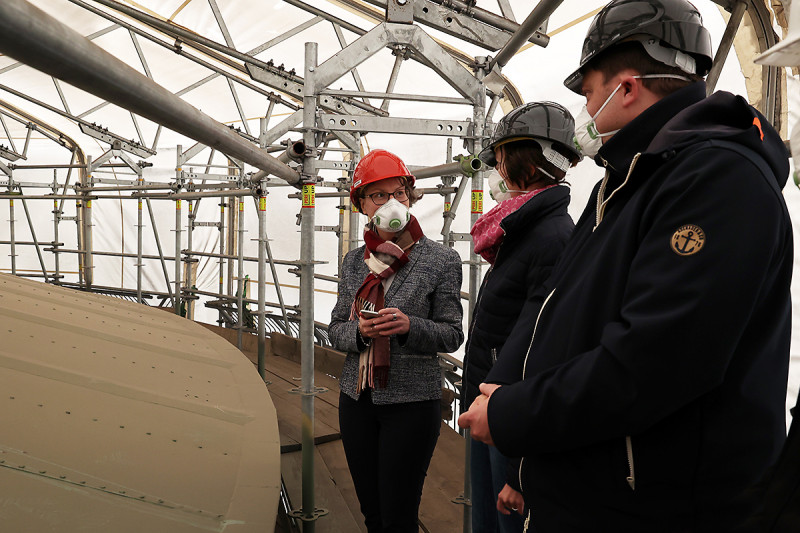
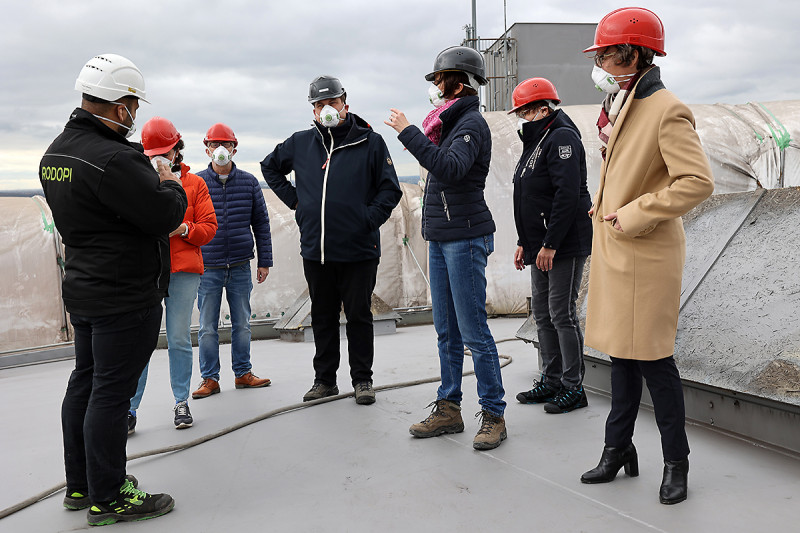
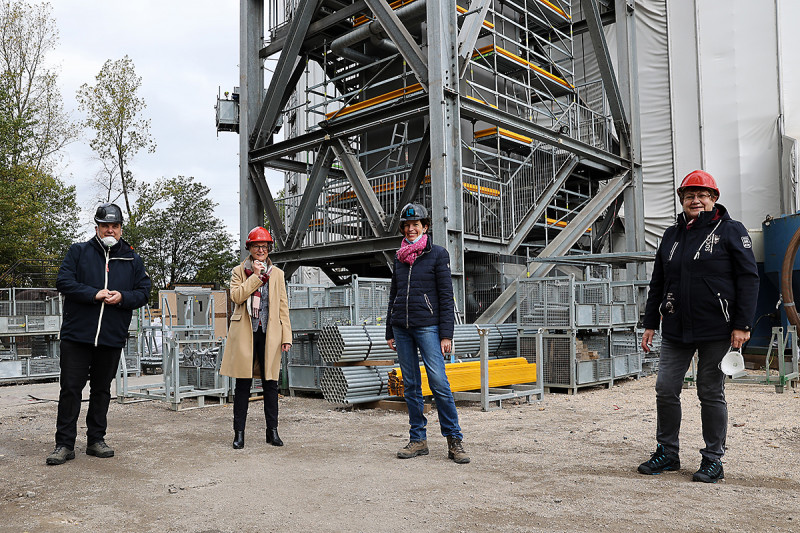
"High" visitors
Gasometer managing director Jeanette Schmitz took the visitors on a tour of the construction site directly to the roof. Ina Scharrenbach, Minister for Home Affairs, Municipal Affairs, Construction and Equality of the State of North Rhine-Westphalia, and Karola Geiß-Netthöfel, Regional Director of the Ruhr Regional Association, accepted the Gasometer Oberhausen GmbH's invitation. The Lord Mayor of Oberhausen, Daniel Schranz, also took the opportunity to find out about the status of the renovation on site. The tour of the construction site led from the roof, which had already been coated, via the external staircase, which had also been completed, to the inner circulation at a height of 110 metres, from where the participants were able to take a look at the special construction of the inner scaffolding. Construction Site Diary October 2020
Fotos: Dirk Böttger
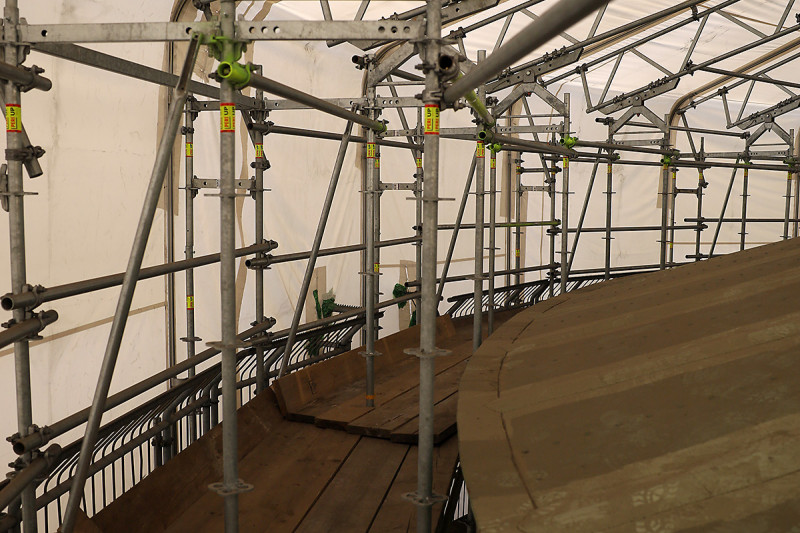
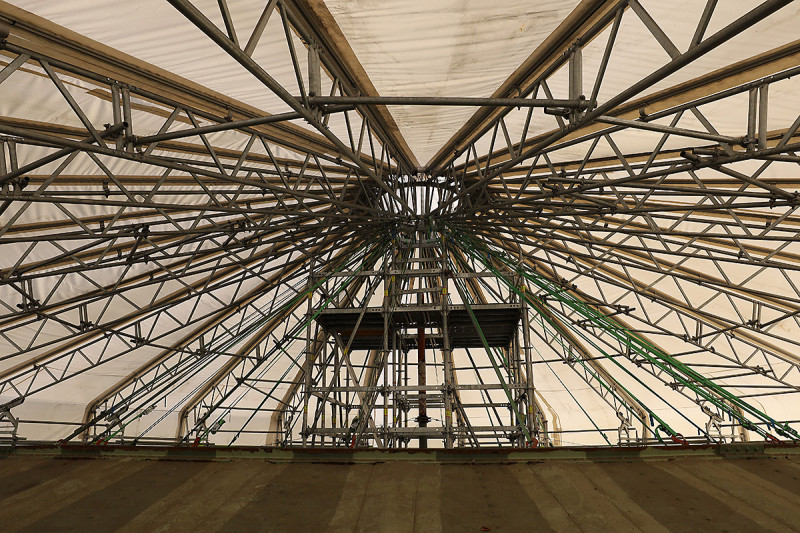
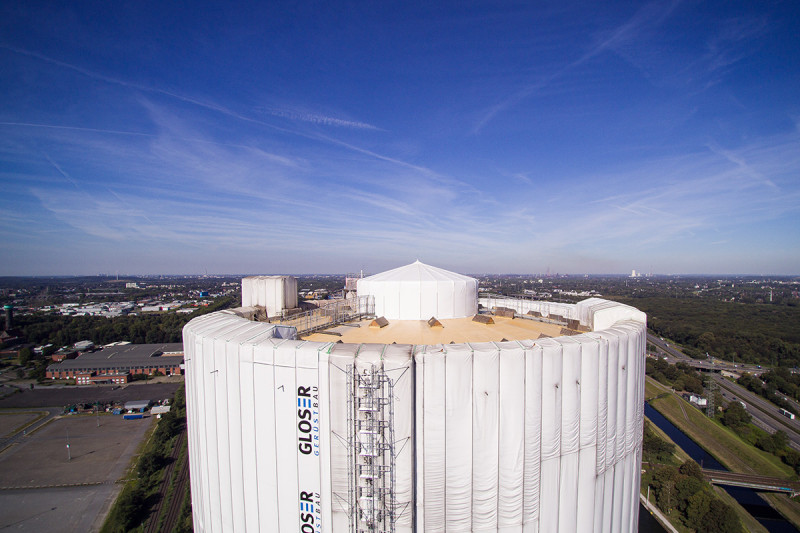
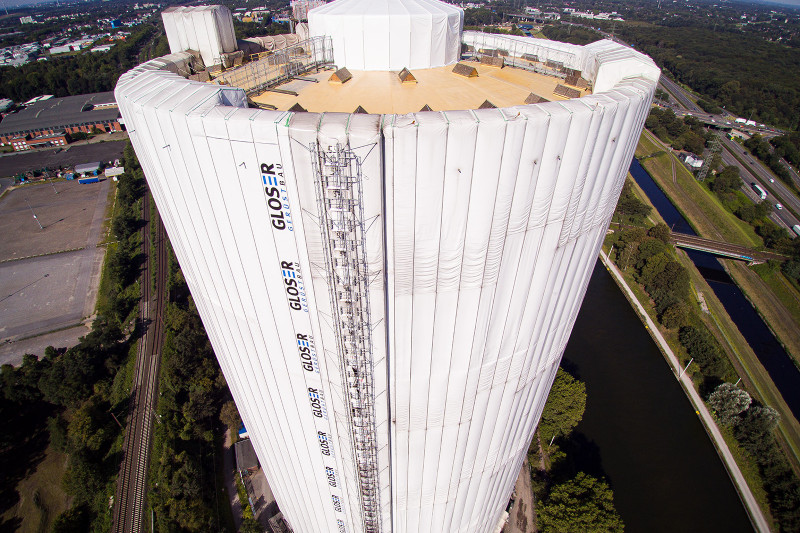
Crowning
Every pot finds its lid: the barrel is also currently adorned with a little crown, because the rotunda on the roof of the Gasometer is now also completely scaffolded. The photos also show a view under the rotunda's enclosure. Construction site diary September 2020
Fotos: Dirk Böttger
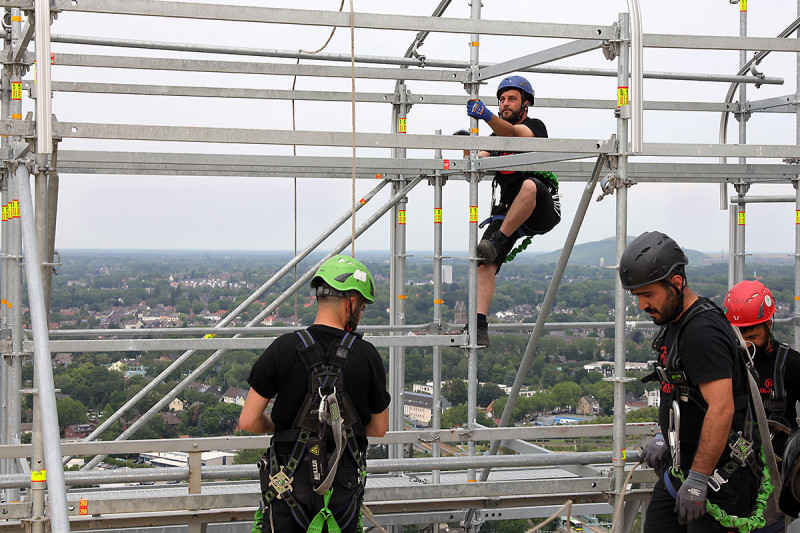
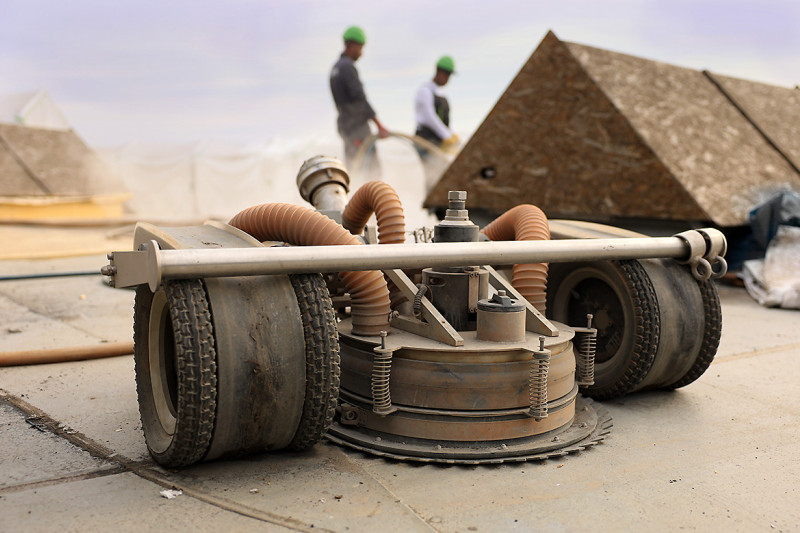
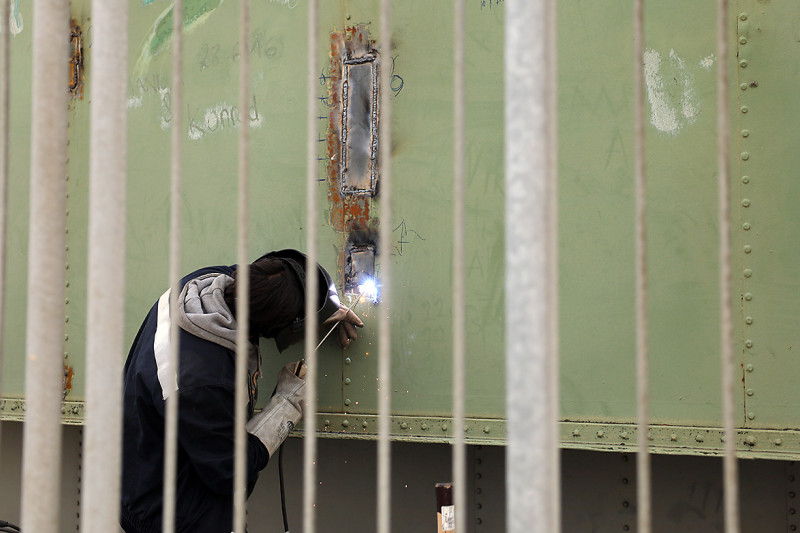
Roof damage
The hustle and bustle at the Gasometer has moved to lofty heights in recent days. The scaffolders have used more than 1,000 tonnes of material and the last tarpaulins are currently being pulled into the 30,000 m² façade scaffolding from the roof. The standard tarpaulin is about 30 metres long, 2.5 metres wide and weighs around 40 kilograms.
While rust and paint are already being removed behind the enclosure in various construction phases using solid blasting technology, the skilled workers from Rodopi are using water jet technology on the roof to remove the layers of paint. The paint particles are bound by the water and sucked off directly to be disposed of properly afterwards. At the same time, welding work is being carried out on the rotunda, as rust has already affected one or two areas there as well.
Constructionsite diary June 2020
Fotos: Dirk Böttger
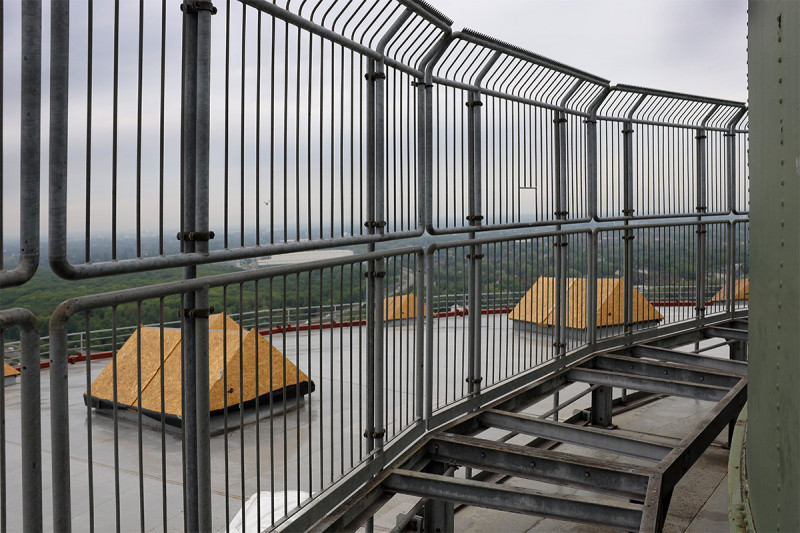
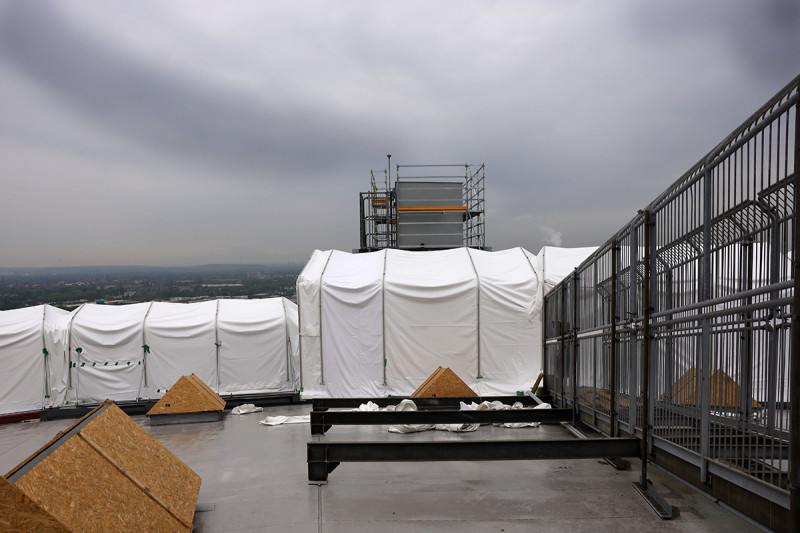
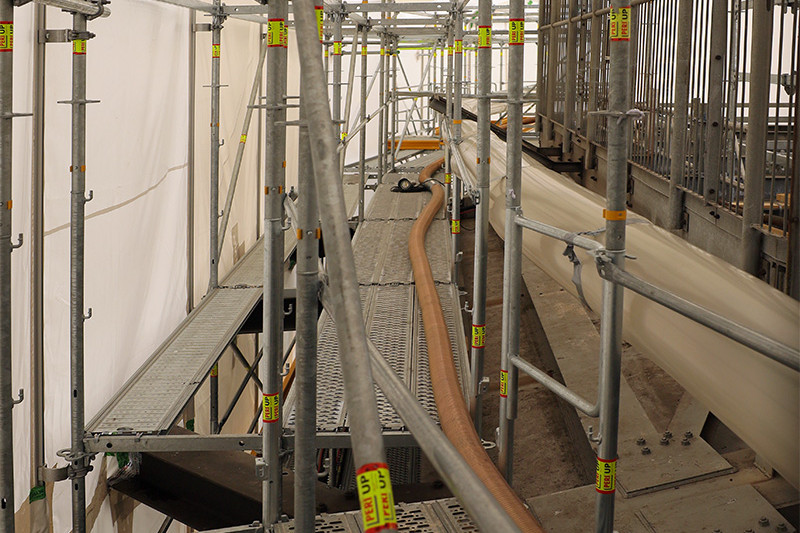
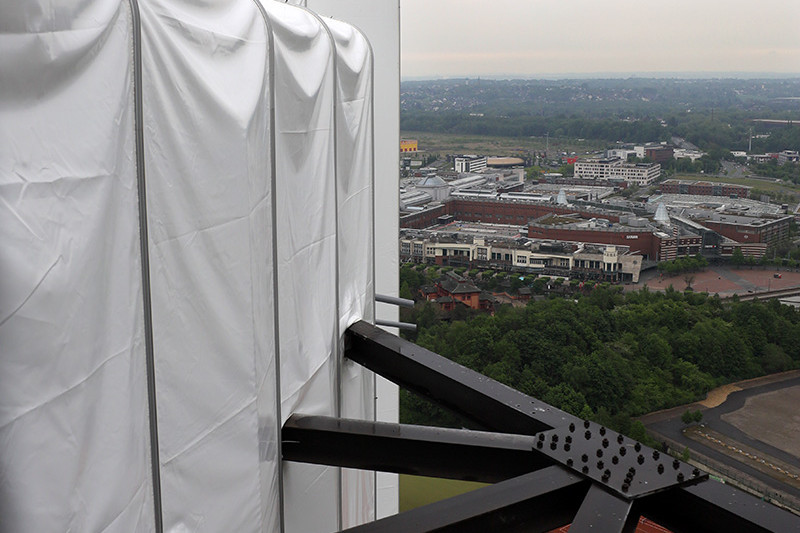
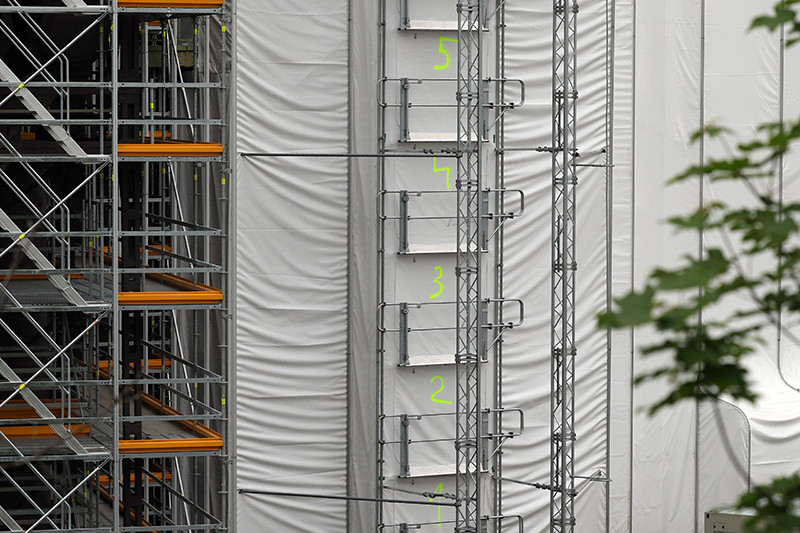
Enclosure, noun, feminine [the].
"Enclosures (singular: enclosure or enclosure) are," according to the all-knowing Wikipedia, "the complete or extensive enclosure of interfering sources of emissions or against hazards from the site environment." In relation to the Gasometer construction site, the enclosure is intended to ensure, on the one hand, that the blasting and painting work is protected from the weather and, on the other hand, that the blasted paint residues remain in the relevant construction site area. For work on corrosion protection, it is crucial that the treated surfaces do not get wet and that constant conditions in terms of humidity and temperature prevail during the drying of the paint layers. For this reason, the tarpaulin used for enclosure also closes off airtight. Only skilled workers with appropriate protective clothing have access to this area.
Construction site diary May 2020
Fotos: Dirk Böttger
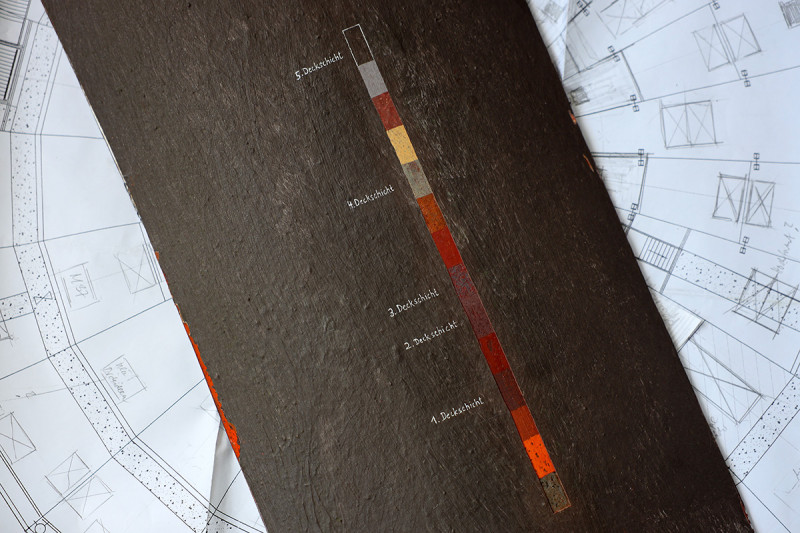
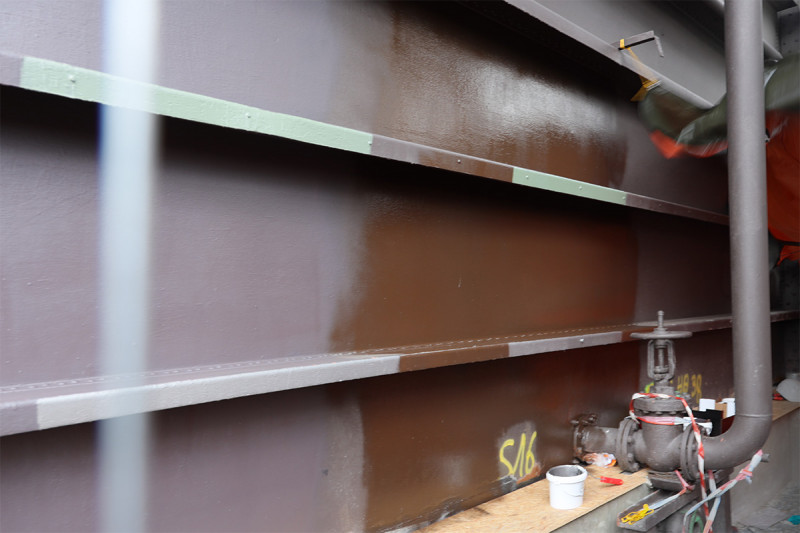
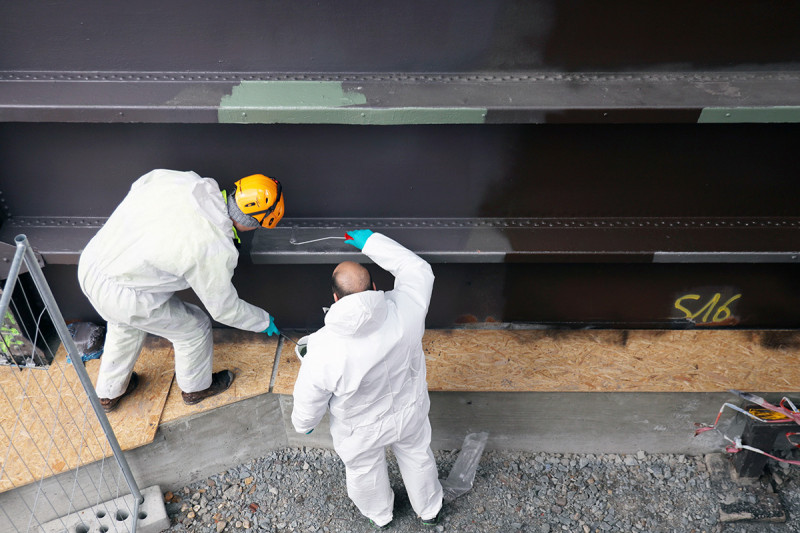
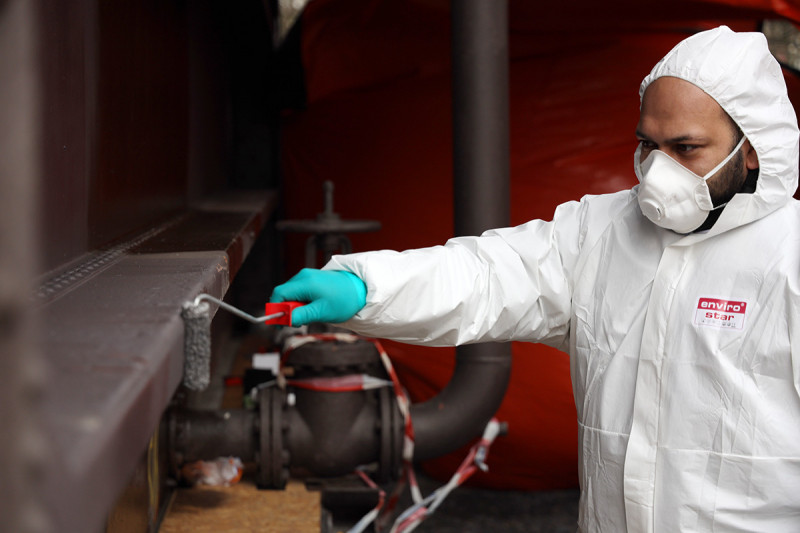
The new old colour of the Gasometer
The decision has been made: The new paint of the Gasometer consists of a grey base colour with an oxide-reddish tint. This mixture represents a contemporary further development of the original brownish-looking colour, which was used as a top coat when the Gasometer was rebuilt in 1949. The new formula, however, contains a proportion of micaceous iron ore, which reinforces the corrosion protection. Offset elements such as the staircases and circumambulations are painted in the shade of green used until then.
Determining the original colour of the gasometer required real detective work, because the gasometer has received more than one coat of paint in its eventful recent history. At least that is what the examinations by restorer Susanne Conrad of the LVR Office for the Preservation of Historical Monuments in the Rhineland revealed. The result was obtained through various examinations. Samples were taken over the entire surface, which were then used for cross-sectioning, pigment and binder analysis.
The laboratory tests revealed a total of 14 layers of paint. This sequence of colours is impressively visualised by means of a so-called uncovering staircase, for which paint layer after paint layer was removed under the microscope. Since the entire gasometer could not be placed under the microscope, three 30x60 cm sample sheets were cut out of one of the blowers, which were then used to reveal the many layers of paint in minute detail under the microscope with a scalpel.
Construction site diary April 2020
Fotos: Dirk Böttger
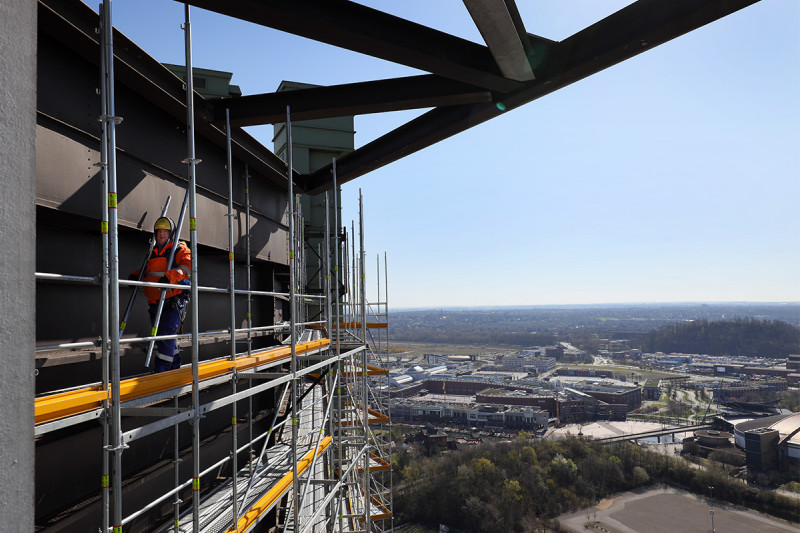
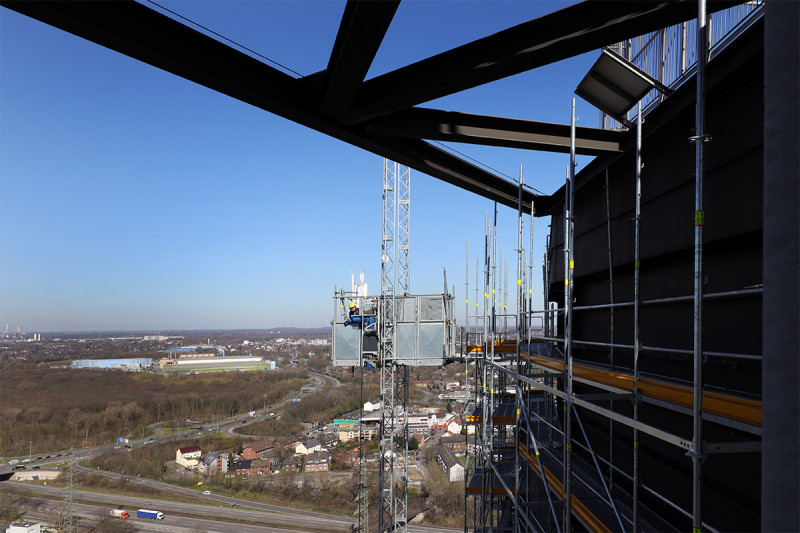
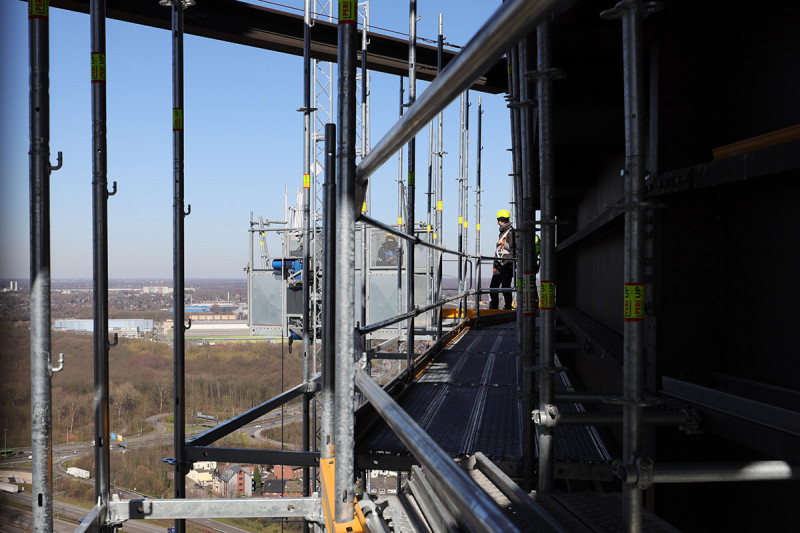
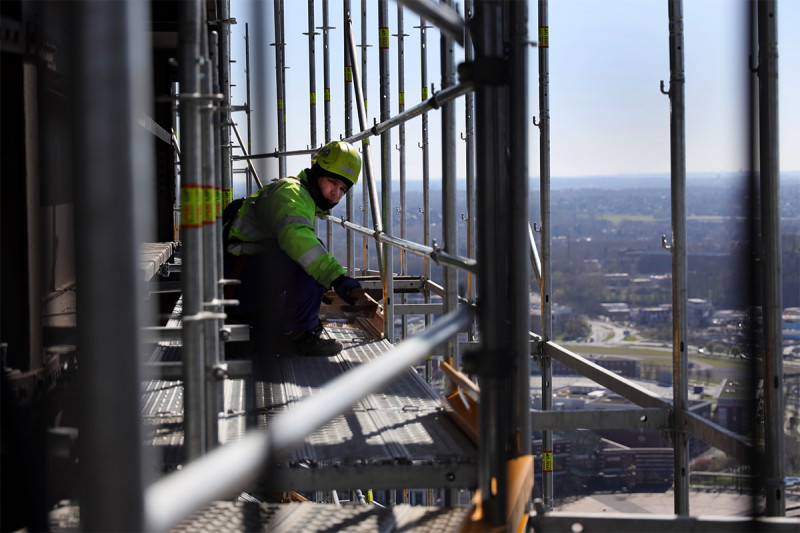
Summit strikers
The scaffolders have been working hard in the last few days and have raised the façade scaffolding to below the roof edge in two construction phases. What the workers are achieving at dizzying heights is simply remarkable. At the same time, the lower sections of the scaffolding are enclosed in foil.
Construction site diary March 2020
Fotos: Dirk Böttger
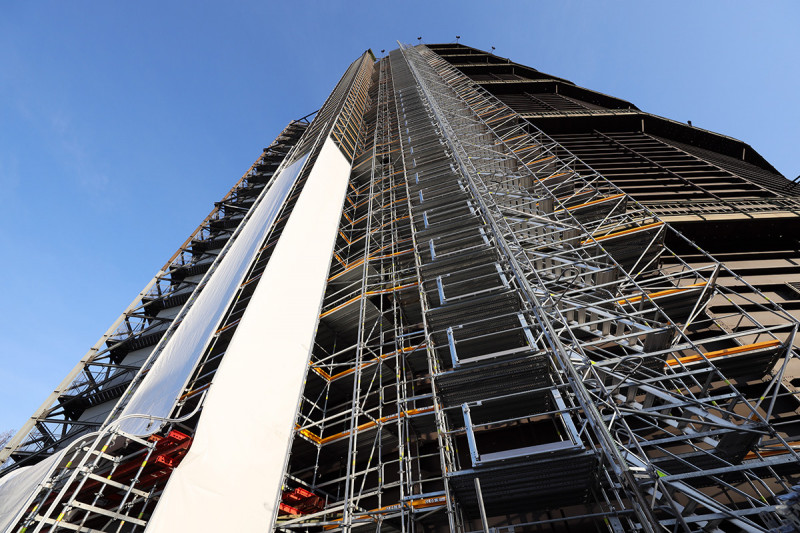
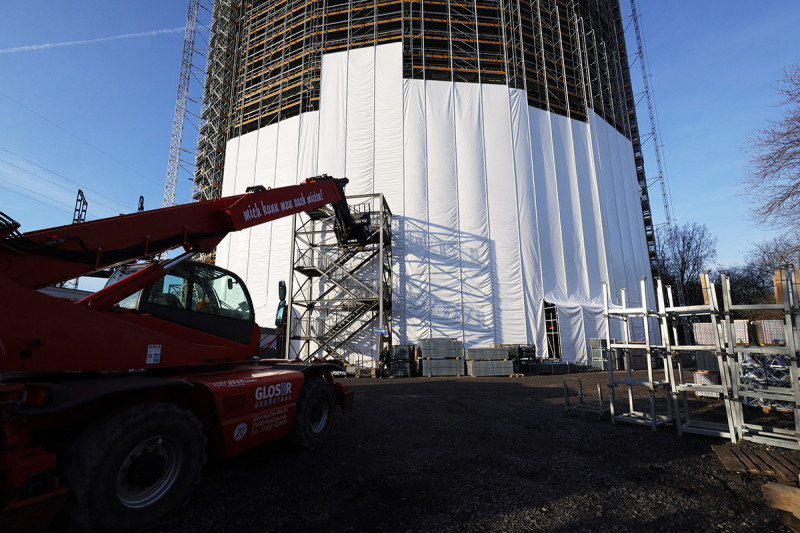
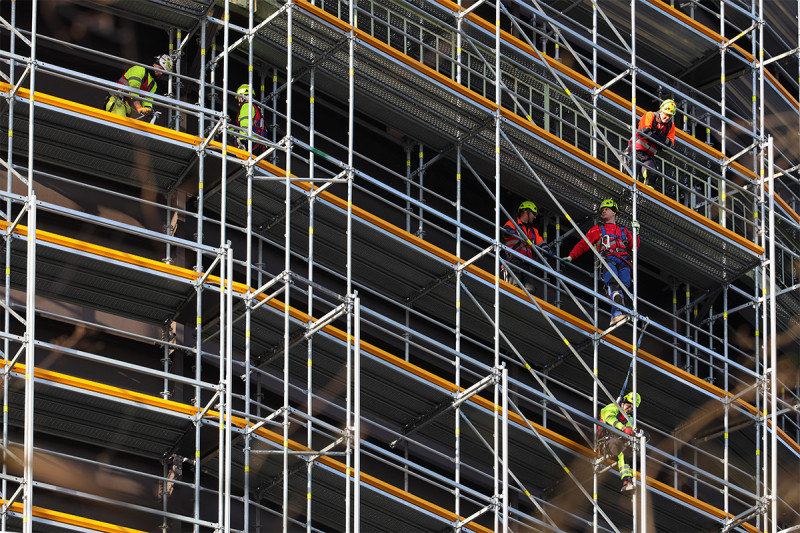
Enclosure
The next construction phase starts on the Gasometer construction site. The façade scaffolding is being enclosed piece by piece with a light-coloured tarpaulin. The tarpaulin ensures that the paint and metal residues left over from the blasting of the shell remain on the construction site. The gasometer is expected to be completely covered between June 2020 and spring 2021. Construction site diary March 2020
Fotos: Dirk Böttger
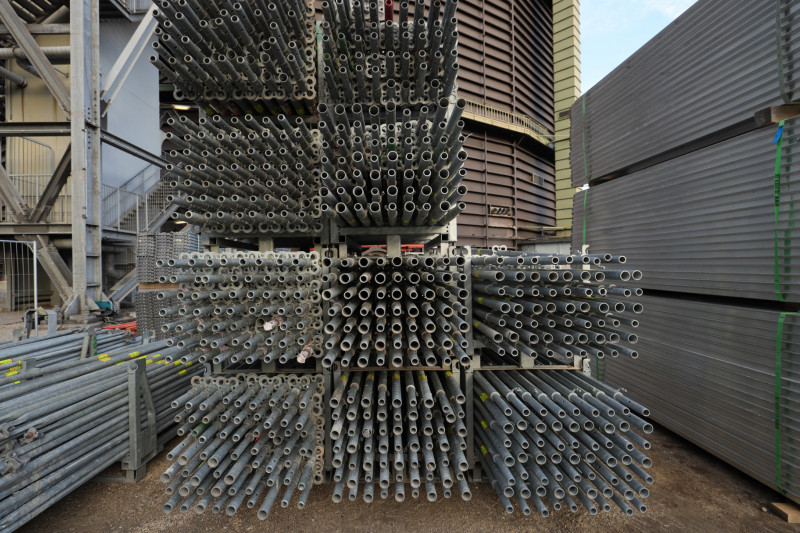
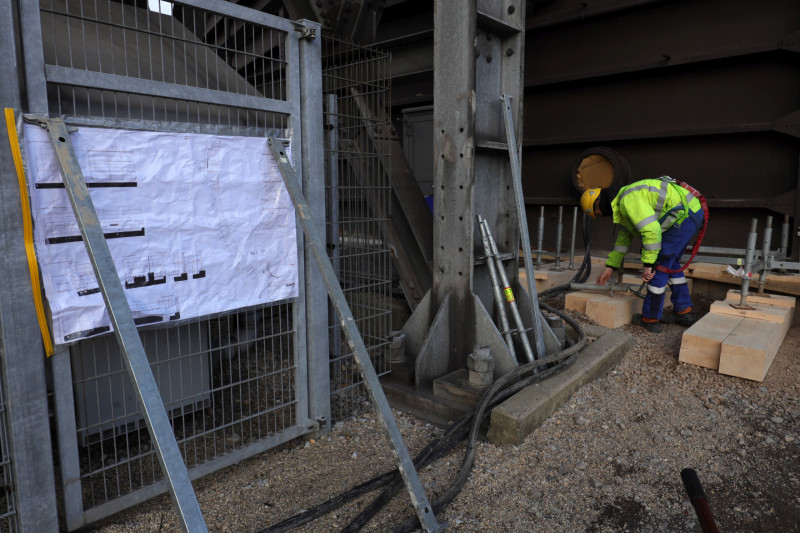
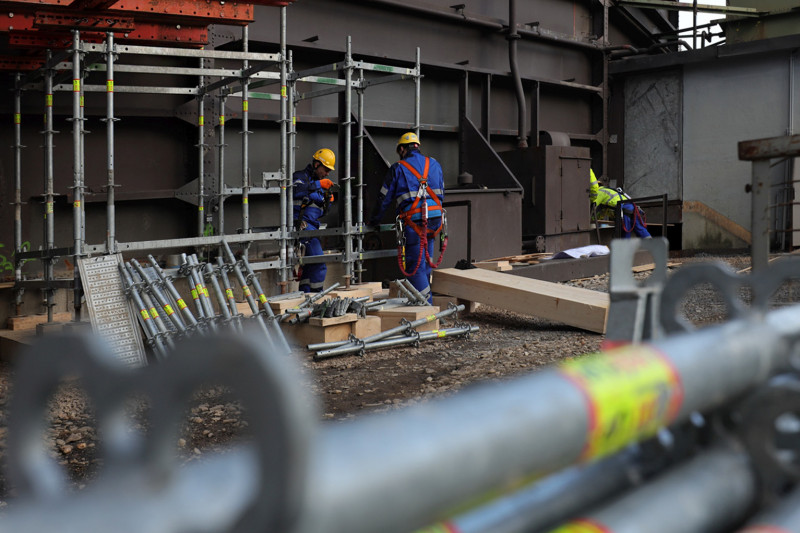
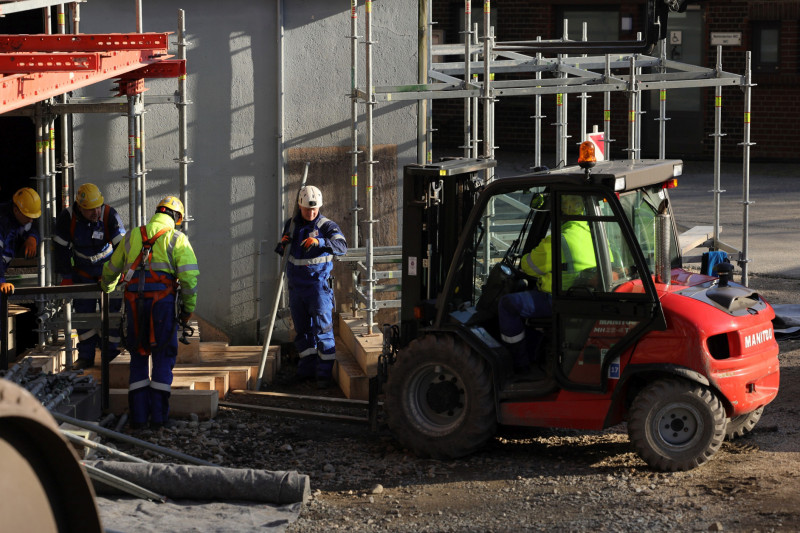
Scaffolding started
Climbers and crane have successfully completed their tasks for the time being. Now it's the turn of the scaffolders, who have begun erecting the façade scaffolding, which covers a total of 30,000 square metres, in two of four construction phases. Construction site diary January 2020
Fotos: Dirk Böttger
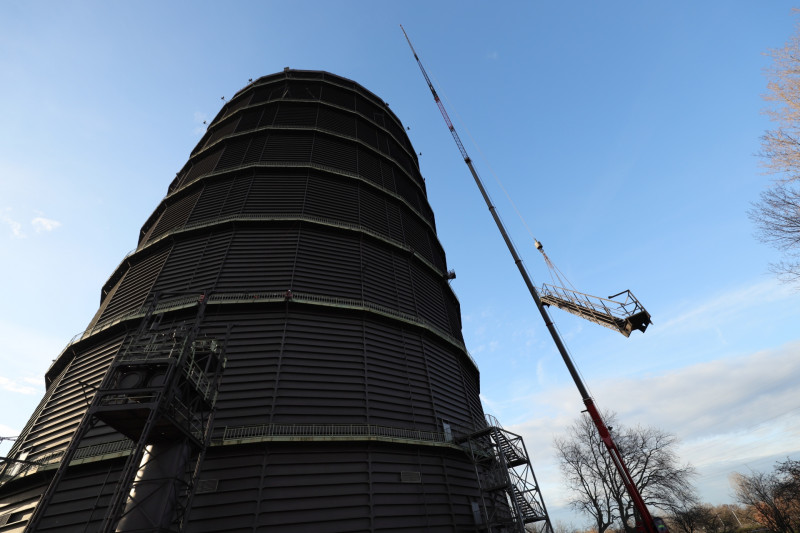
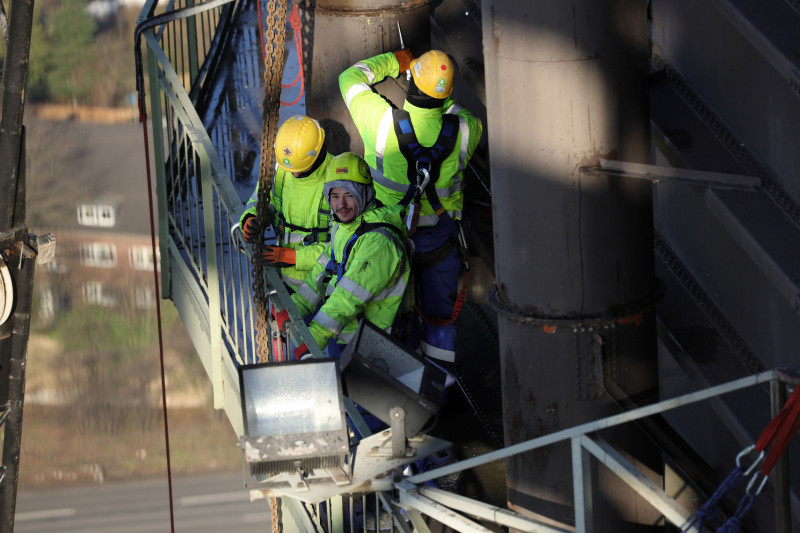
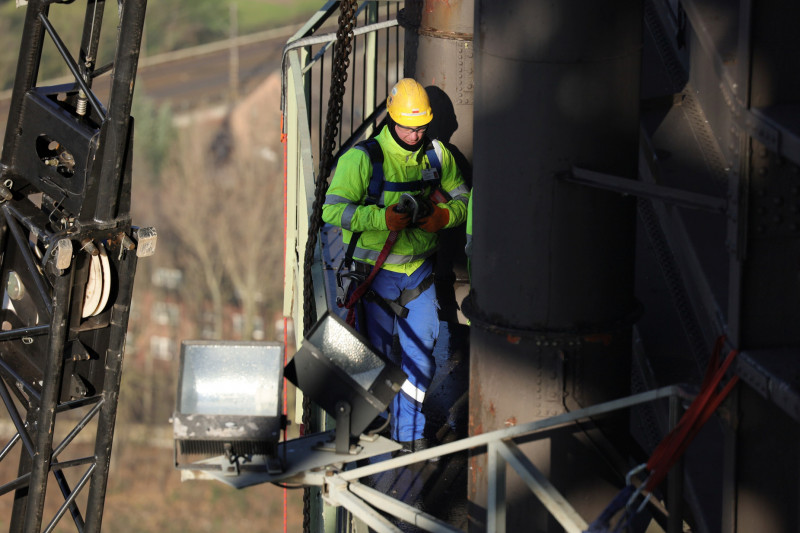
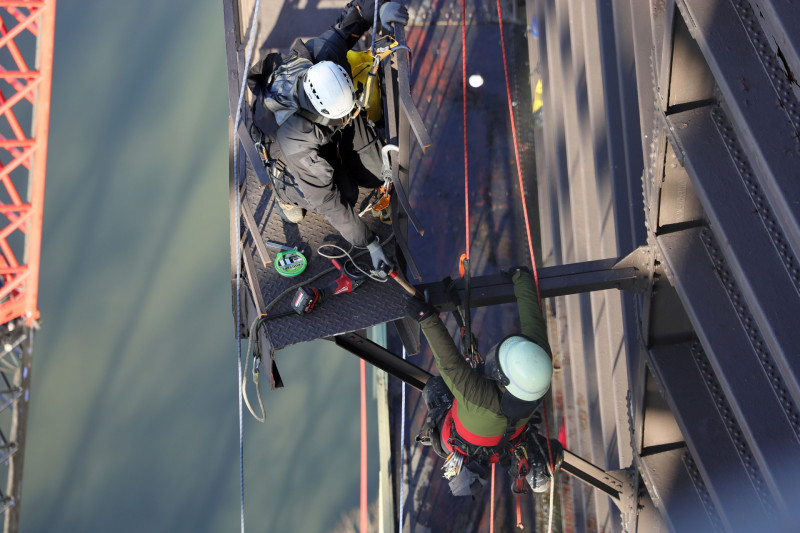
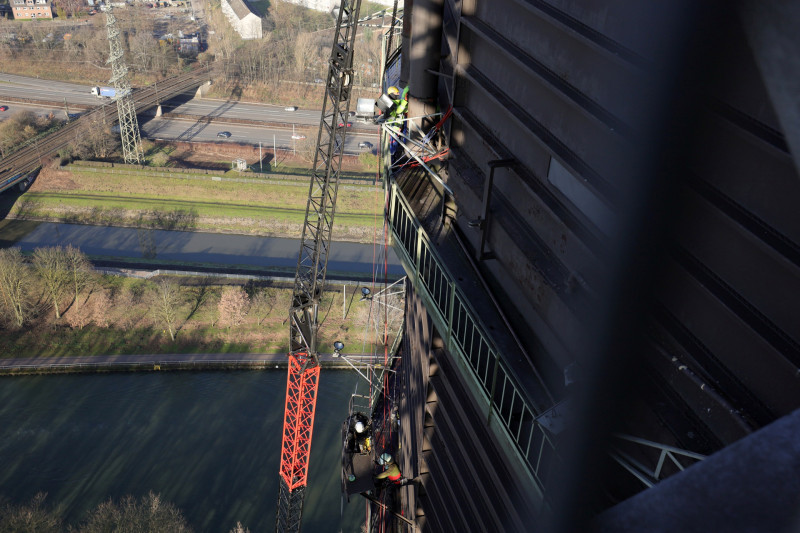
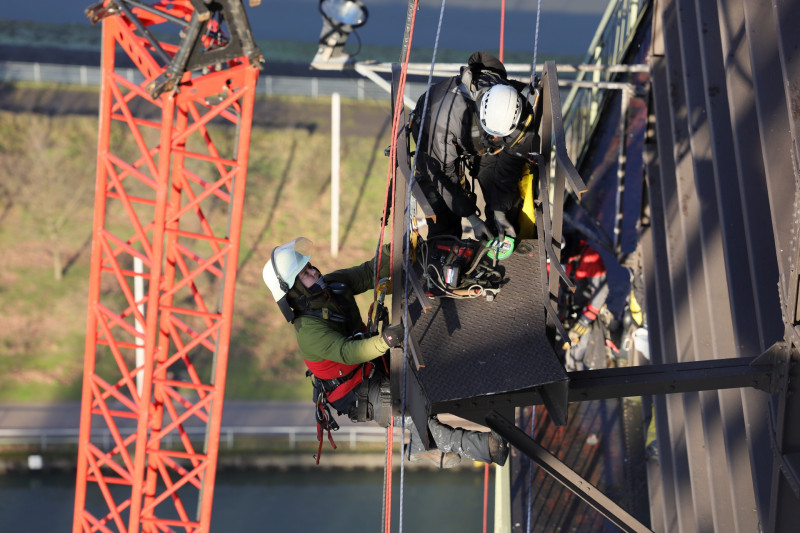
Dismantling work completed
In the last few weeks, industrial climbers have dismantled the circumferential stairs on the outer shell of the Gasometer as well as the total of twelve blowers on the edge of the roof. The professional climbers were assisted by the 120-metre-high, 300-tonne special crane that had already been erected at the beginning of the month. *Construction site diary January 2020
Fotos: Dirk Böttger
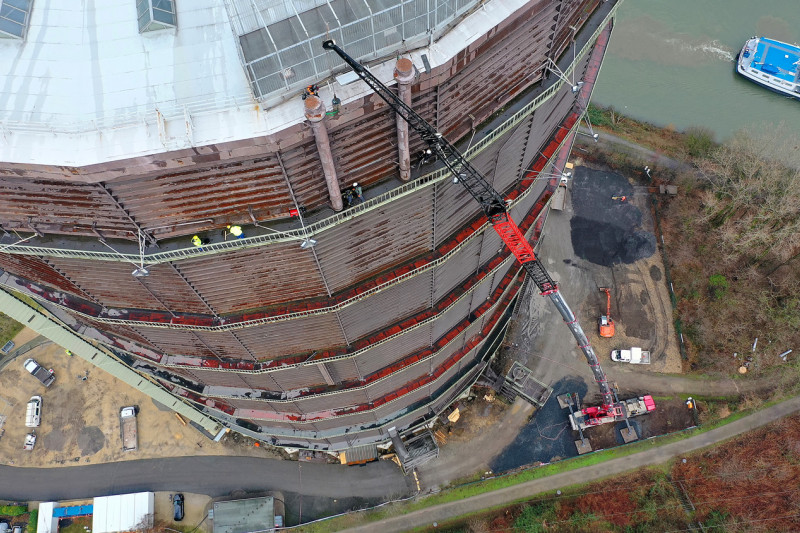
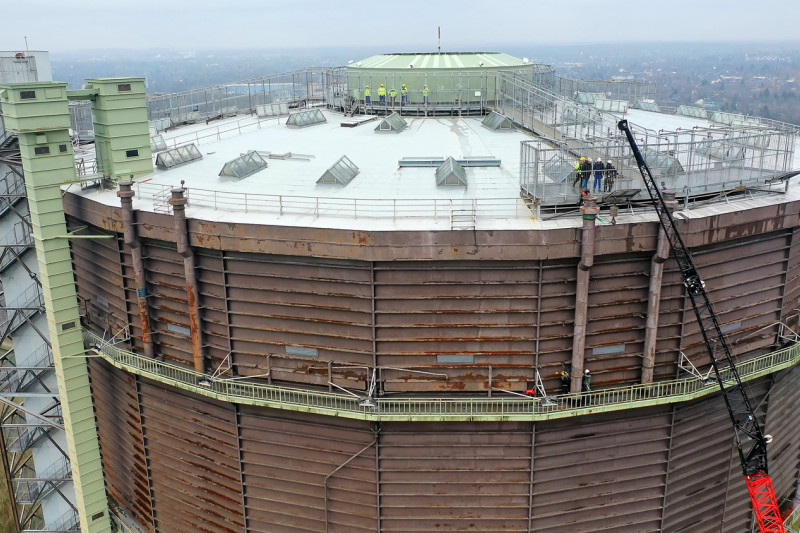
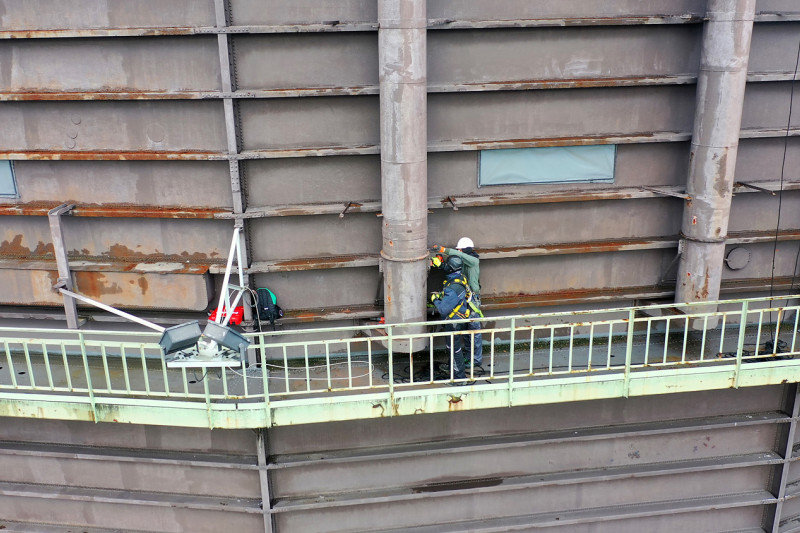
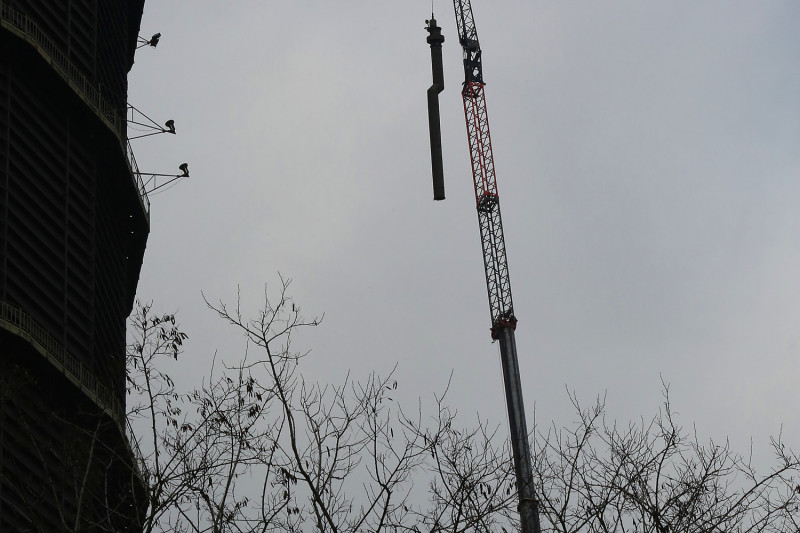
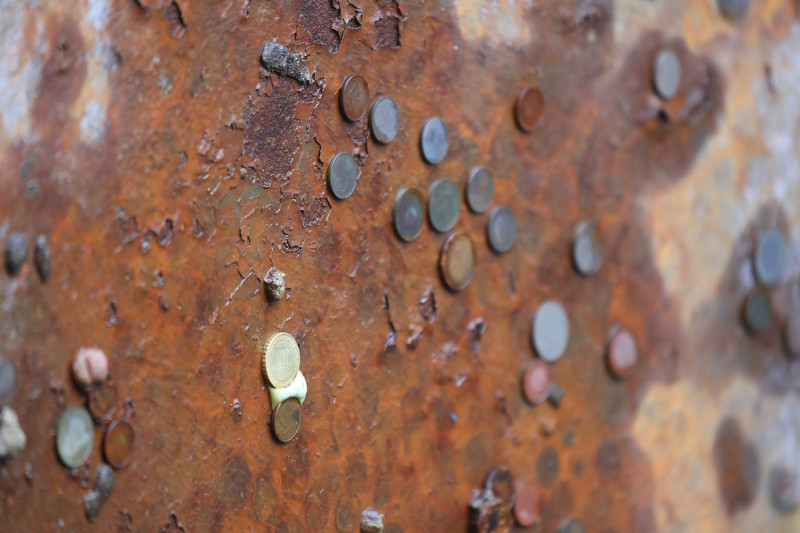
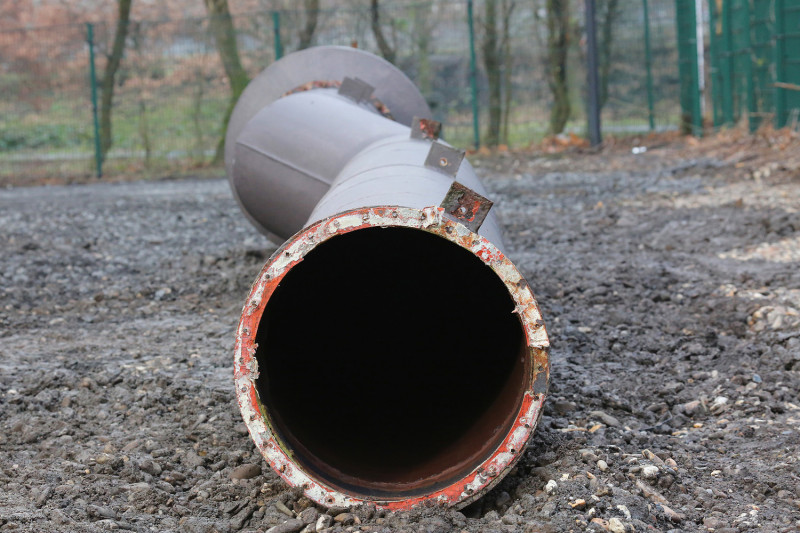
Dismantling at a height of 117.5 metres
The industrial climbers need good nerves of steel to dismantle the blowers on the roof of the Gasometer. The dismantled blowers are lifted off the roof with a crane, transported away on a low-loader and completely overhauled in a specialist workshop. Towards the end of the renovation project, they will be returned to their original place.
Construction site diary January 2020
Fotos: Carsten Walden
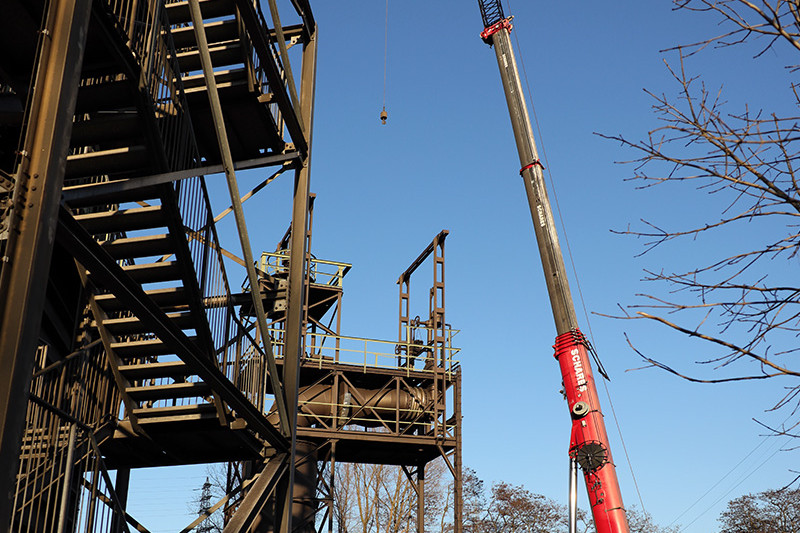

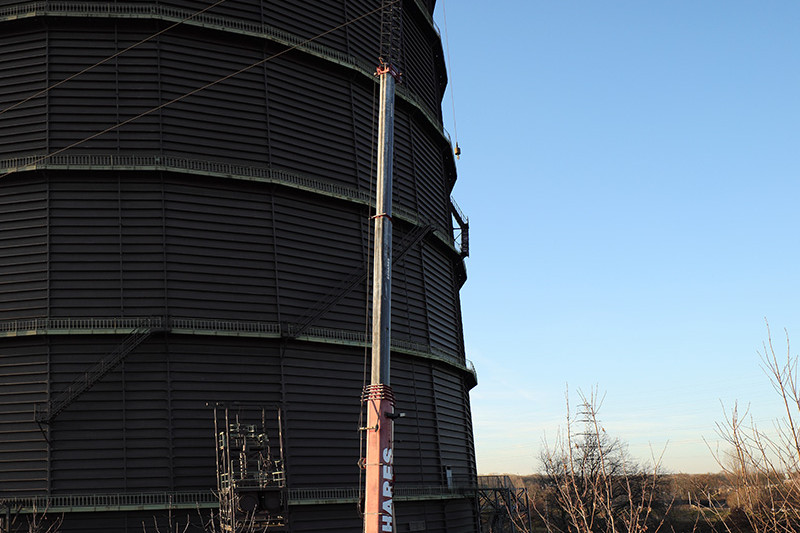
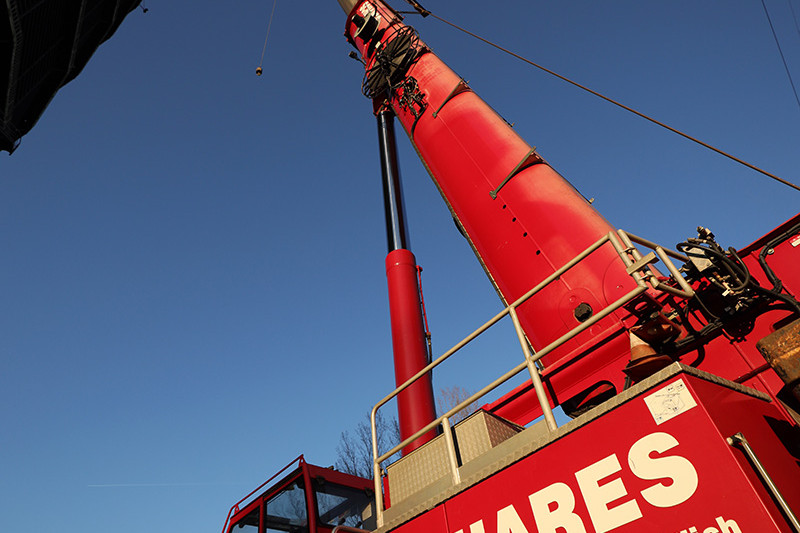
Crane complete
Within just one day, the crane is in place and ready for use. With the help of the Grove GMK 5250L, the staircases between the circumambulations on the outer shell of the gasholder as well as the blowers and railings will be dismantled in the coming days. This will be followed by the scaffolding. Construction site diary January 2020
Fotos: Dirk Böttger
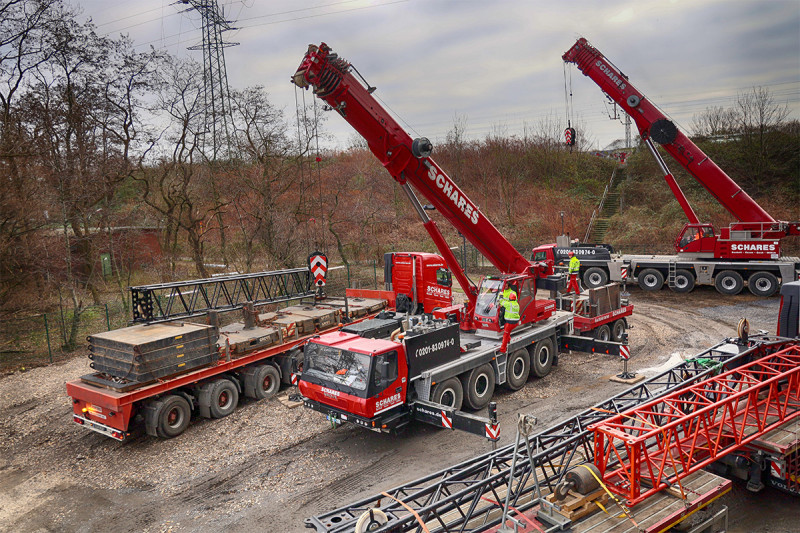
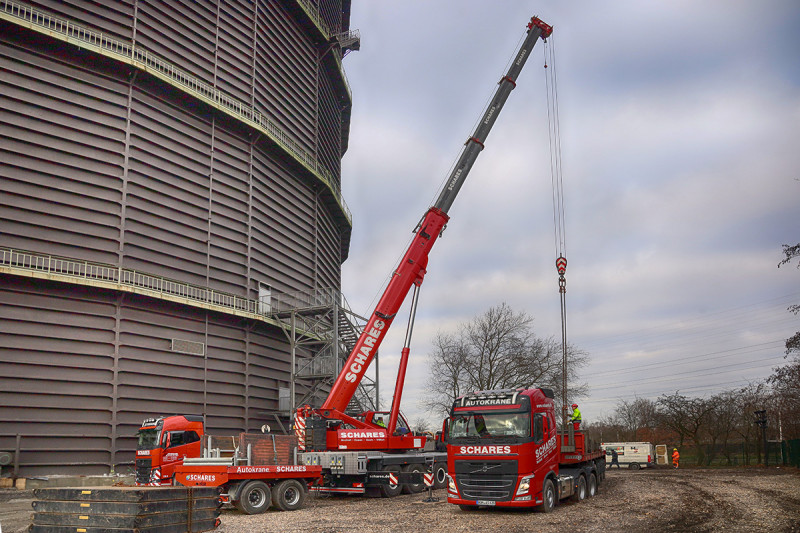
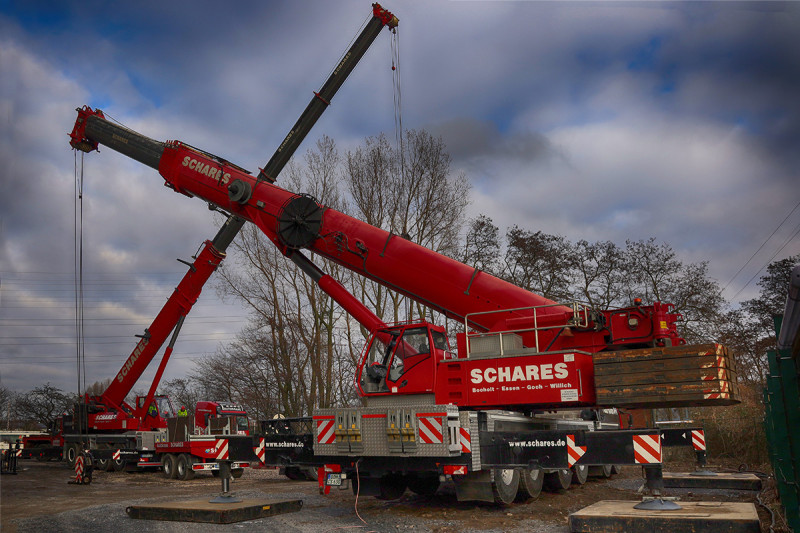
Aiming high
Before the gasometer can be scaffolded in preparation for corrosion protection work, some parts on the outside still have to be dismantled. At a height of up to 117.5 metres, this is quite a challenge. A large crane is needed, and to ensure that it reaches the necessary height, a small crane helps to assemble it. Construction site diary January 2020
Fotos: Dirk Böttger
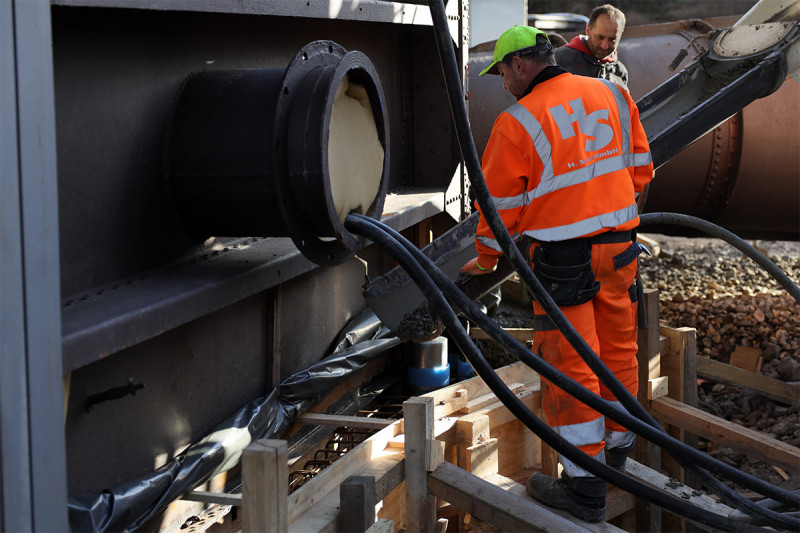
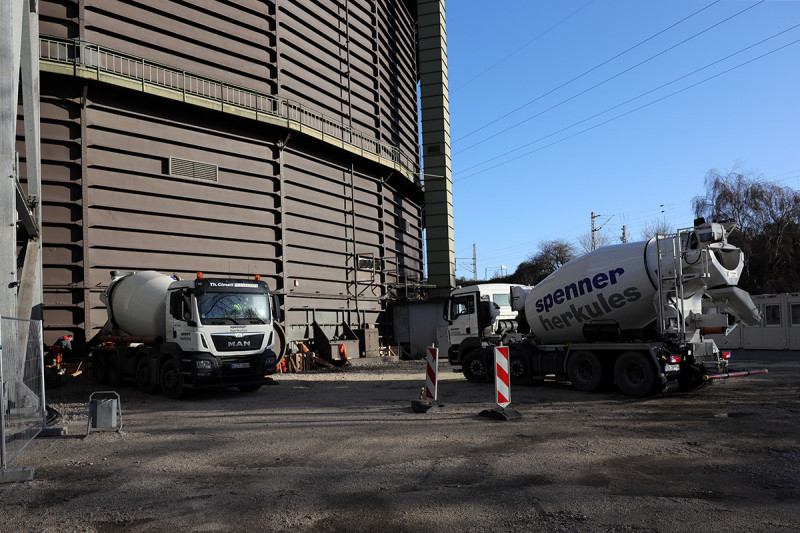
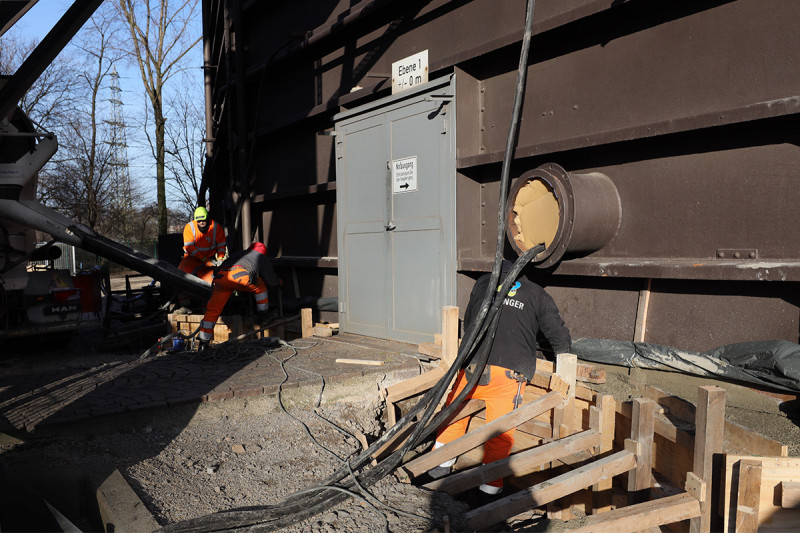
From the ground up
The renovation of the Gasometer begins with something fundamental: repairing the foundation. This was first exposed in parts and, where necessary, reinforced with steel mats and re-cast. Construction site diary December 2019.
Fotos: Dirk Böttger

